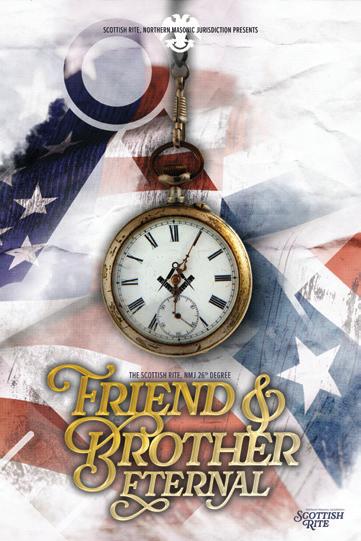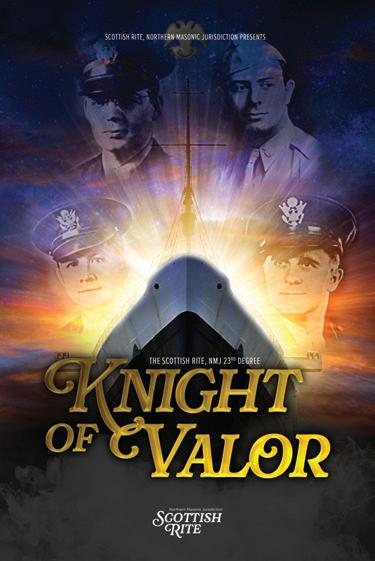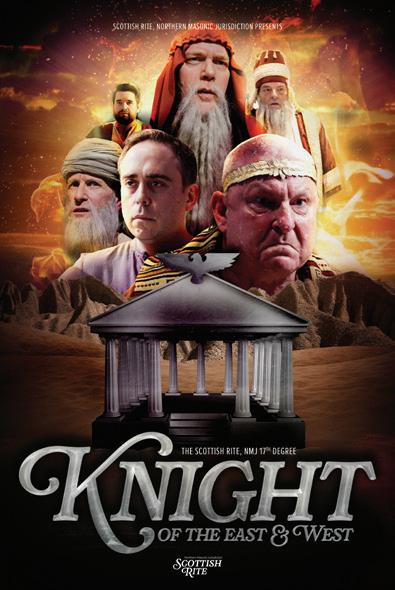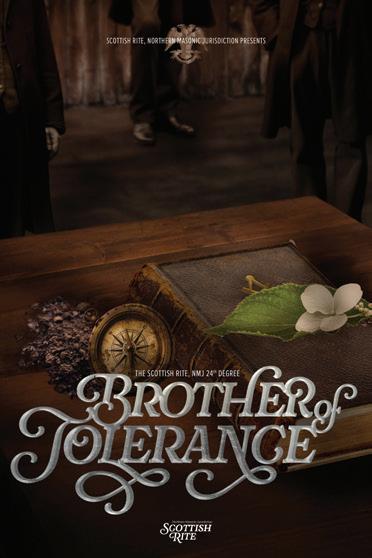








As the Scottish Rite’s oldest jurisdiction-wide fundraising appeal, the Blue Envelope is a tangible way for our fraternity to join together and fulfill our commitment to our Brothers and our communities. Donations to the Blue Envelope directly support our Scottish Rite Charities .
Just as you have a profound impact on our Scottish Rite Charities, Blue Envelope donations have a positive impact on your Valley. Every Blue Envelope donation helps your Valley get one step closer to becoming a Valley of Excellence.



mysteries of Oak Island have captivated the imaginations of people for more than two centuries. It is
more intriguing to members of the Craft owing to its supposed connection to
and the Knights Templar. In this issue, we take a look at one of the many theories of just what that treasure may be in our interview with Corjan Mol and Brother Christopher Morford, 32°, coauthors of The
Official (and Unofficial) Music for the 32nd Degree in the Early 20th Century

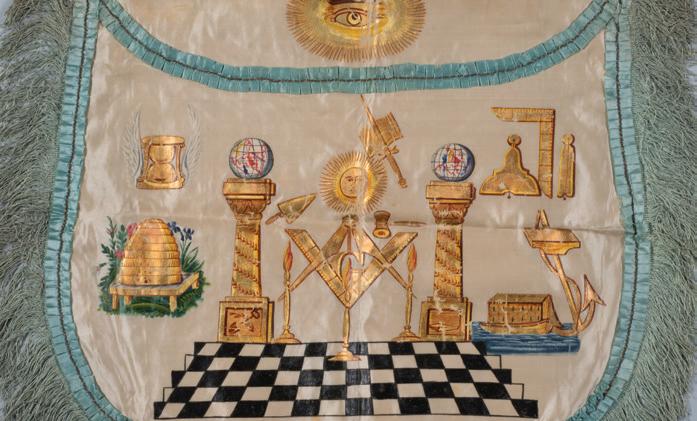




My journey as a Freemason began in 1977, a year when I was also part of a vibrant bowling league with my new bride, Vickie. Both hobbies fostered camaraderie among friends and neighbors. Unfortunately, bowling leagues, like Freemasonry, have endured steep declines in membership in the last 50 years.
While the popularity of bowling leagues may be on the decline, bowling as a hobby has endured and evolved. The more formalized bowling leagues of yesteryear gave way to centers serving as gathering spaces for people from all walks of life to
enjoy a cold beer, celebrate a birthday, or even memorialize a lost friend. The focus shifted from bowling as a formalized sport to bowling as being an approachable hobby that people of all ages could enjoy. As the proud owner of a bowling center in Michigan that has remained a successful business venture for over 30 years, I witnessed this transformation first-hand.
by Walter F. Wheeler, 33˚ Sovereign Grand Commander
Just as bowlers adjust their stance and approach for a perfect strike, we as Freemasons also must adapt and enhance our approach to ensure that our storied organization remains relevant in the future. Some Valleys’ gathering spaces have changed, and we have embraced technology with “Rite on the Road” to help bridge that gap.
Think about the thousands of men that we kick out of our Fraternity every year, because they didn’t pay their dues. To me, that’s a sin; it means we failed.
Perhaps a growing number of Brothers in your Valley are younger professionals who can’t easily get to a weeknight event. That’s where our ever-popular Thursday Night at the Rite online degree presentations fulfill a need. Those programs only skim the surface of ways that we can embrace technology, and Supreme Council continues to explore other digital avenues. From perfecting a degree presentation by

leveraging AI (artificial intelligence, for us older folks) to embracing TikTok like our friends within the Scottish Rite Southern Jurisdiction, the possibilities are endless.
No matter what technologies we embrace, the light of our Craft remains as bright as it was over 300 years ago. That is why our Brotherhood endures. Still, we need to take a long, hard look at our membership processes and assess whether they still work for us in 2024.
In the 1890s, joining my lodge required a significant fee of $100 (a pretty penny in the 1890s!), while annual dues were just $5. It’s disheartening to know that now, thousands of men leave our Fraternity each year due to financial barriers.
We have historically seen dues as a means of maintaining the organization, but we need to rethink this approach. Think about the thousands of men that we kick out of our Fraternity every year because they didn’t pay their dues. To me, that’s a sin; it means we failed. When we’re losing Brothers out the back door, that’s on us.
Maybe we need to look at a scenario where you pay a fee, and you become a member forever – like a prepaid lifetime membership. Imagine the countless hours and tens of thousands of dollars every year we would save by not having to track down dues.
Just as bowlers adjust their stance and approach for a perfect strike, we as Freemasons also must adapt and enhance our approach to ensure that our storied organization remains relevant in the future.
With a full year as your Sovereign Grand Commander in my rear-view mirror, a significant lesson I have learned is that while we may not all see eye to eye on any particular issue, we all want our organization to thrive. Just as bowling joins people to share laughter and camaraderie, Freemasonry offers a path to connect with one another, too. United, we can rekindle that spirit of togetherness, extending our bonds beyond the walls of our lodges and Valleys into the very fabric of society.
The future of our Fraternity rests with us! Journey On, my Brothers.

by PJ Roup, 33˚, Editor Active for Pennsylvania
“The deed is everything, the glory nothing.”
— Johanne Wolfgang von Goethe, Faust

From1992 to 2006, I had the privilege of singing with the Mendelssohn Choir of Pittsburgh under the direction of Maestro Robert Page. To my knowledge, Bob was not a Mason, but he embodied, both in spirit and in action, many of the virtues that Masons endeavor to practice. First and foremost, he was a teacher – and not just of music. He would often wax poetic from the podium – dispensing life lessons he learned from his youth in Abilene, Texas, his experiences on the stage, or from his almost 50 years as one of the foremost choral conductors in the world.
We are too quick to classify what should simply be considered acts of decency as favors.
One snowy night years ago, we were at the final rehearsal for a very challenging piece of music. We knew that there was still work to be done if it was to be perfect, and all of us, including Bob, were feeling the pressure. At a break in the rehearsal, a young man, new to the group, peered out a window and saw that there was quite a bit of snow on the ground. He called his roommates and asked if the buses were still running. “No. It looks like service was suspended because of the snow,” was the reply he got.
This young man who knew no one in the group particularly well, summoned the courage to approach Bob and timidly ask, “Maestro, I hate to be a bother, but could I ask you for a favor? Is there any way I can get a ride home with you after rehearsal?”
“Absolutely,” Bob replied. “Don’t think a thing of it.”
That, in and of itself, is not so remarkable. What happened next was. As we returned from our break, mentally steeling ourselves for another exhausting hour of intense rehearsal, this two-time Grammy winner put down his baton, pulled up a stool,

and began to teach a life lesson.
“I was just asked to do someone a favor, and I wanted to talk a little about what that means,” he began. “A student asked me to give him a ride home tonight. He lives less than one block off my route home. Now is that a favor? Is it really doing someone a favor to drop them at a house that I was driving by anyhow?
“To me, doing a favor for someone,” he continued, “should imply a hardship or inconvenience on the bestower. We are too quick to classify what should simply be considered acts of decency as favors. A favor would have been
driving him to the opposite side of Pittsburgh. A favor is changing a stranger’s tire while you are wearing a tuxedo or mowing an elderly neighbor’s lawn on a scorching summer day. We all may need help sometime, so we should all be prepared to give it when we can – even if it isn’t convenient.”
Wouldn’t worthy men rush to our doors if they saw us treating each other as priorities –as family?
In his own way, Bob did me a favor that night. He gave up several precious
minutes of much-needed rehearsal time to teach a lesson that will stick with me forever: We should consider the needs of others over our own needs, and that we should do things for people, not because it makes us feel good, but because it is the right thing to do.
Do I live up to that standard all or even most of the time? No. Some excel at putting others first, but most of us know we could improve. We sometimes focus on the glory, not the deed, or we assume someone else will pick up the slack for us. As Masons, we are taught to be charitable. Commonly, we believe that charity has to do with being generous with our money, but we

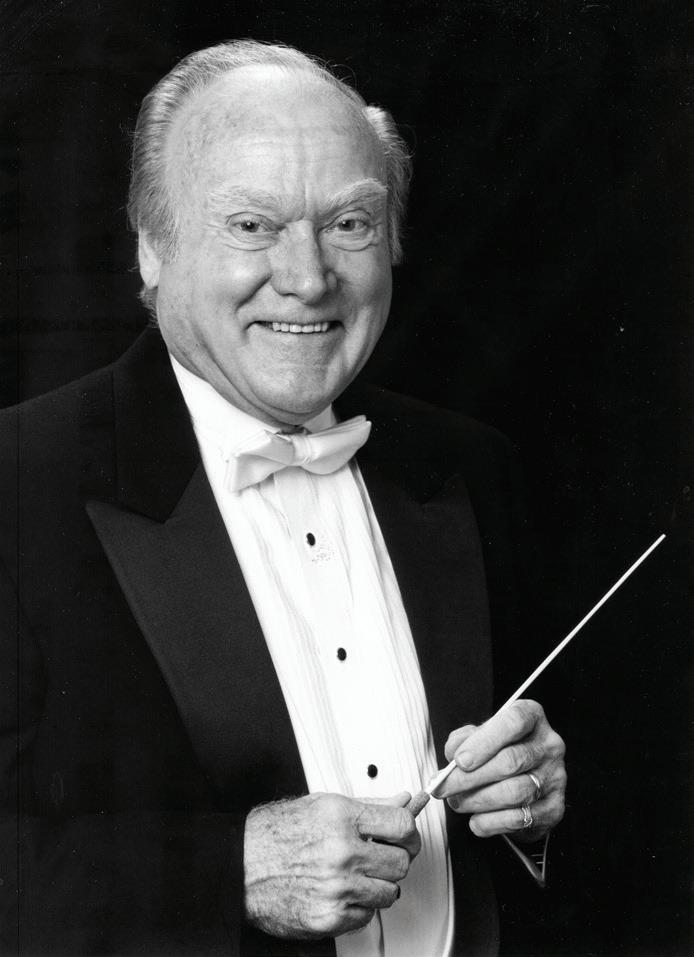
need to remember to be charitable with our time and our talents as well. Often, those are more difficult commodities to part with as they seem perpetually to be in short supply.
I just recently had a conversation with a member who spent several days helping another Brother and his wife prepare to move into the Masonic retirement home. He helped them sort through their finances, gather medical histories, and complete the applications. He also arranged tours of the facilities, as neither had ever visited. A lot of the work was outside his comfort zone, but he understood the Masonic call to service and took seriously the Scottish Rite motto: We will strive to be a Fraternity that fulfills our Masonic obligation to care for our members. He came away seeing it as one of the more enriching experiences of his Masonic life.
Brethren, how much better could we be if we all took the call to service (or any of our Core Values for that matter) as a paramount duty? Wouldn’t worthy men rush to our doors if they saw us treating each other as priorities – as family? What is stopping us? There is always time. No matter how busy we think we are, we find the time to do the things that matter to us. Make Masonry matter. The simple fact is that your Valley (and your lodge) needs you to do them a favor. It needs your talents, whatever they may be. It needs your treasure to provide services and programs to our members, and it needs your time (read, your presence) at their events.
Thoreau said, “In the long run, men hit only what they aim at.” Perhaps we need to adjust our sights then. A new year is almost upon us. Let’s resolve to make 2025 a year where we live our Core Values.
Pick one. Improve.
Devotion to Country? Volunteer to help veterans. Reverence for God? Go on a mission trip. In short, aim at something new. Integrity, Justice, Tolerance, or Service to Humanity? There is always room for improvement. It might not be easy, but the reward will be great. Do yourself a favor: not the easy kind, but the hard one. Give a little more time or talent or treasure to Freemasonry. Commit to working harder for yourself and the men you call your Brothers.
Do yourself a favor and try.
A magazine of 32˚ Scottish Rite Freemasonry Fall 2024 | Vol. 55 | No. 3
SOVEREIGN GRAND COMMANDER
Walter F. Wheeler, 33°
EXECUTIVE EDITOR
Linda R. Patch
EDITOR PJ Roup, 33°
CREATIVE DIRECTOR
Rodney E. Boyce, 33°
CONTENT MANAGER Joann Williams-Hoxha
DIRECTOR OF DESIGN
Matt Blaisdell, 32°
COMMUNICATIONS COMMITTEE
Richard J. Powell, 33°, Chairman Donald G. Duquette, 33° PJ Roup, 33° J. Brian McNaughton, 33° Donald M. Moran, 33° Joann Williams-Hoxha
SUPREME COUNCIL, 33° Ancient Accepted Scottish Rite, Northern Masonic Jurisdiction, U.S.A.
THE NORTHERN LIGHT (ISSN 1088-4416) is published quarterly in the Spring, Summer, Fall, and Winter by the Supreme Council, 33°, Ancient Accepted Scottish Rite, Northern Masonic Jurisdiction, U.S.A., as the official publication. Printed in U.S.A. Periodicals postage paid at Boston, MA, and at additional mailing offices.
POSTMASTER
Send address changes to The Northern Light PO Box 519, Lexington, MA 02420-0519
MAILING ADDRESS PO Box 519, Lexington, MA 02420-0519
EDITORIAL OFFICE
33 Marrett Road (Route 2A), Lexington, MA 02421 phone: 781-862-4410 email: editor@srnmj.org
WEBSITE: www.ScottishRiteNMJ.org
@TNLMagazine
Copyright ©2024 by Trustees of the Supreme Council of the Ancient Accepted Scottish Rite of Freemasonry for the Northern Masonic Jurisdiction, U.S.A.
During a visit to the University of Louisiana, Lafayette RiteCare Center, a concern was expressed about the changing weather and a worry that children and their parents would have to park far away and walk through inclement weather to reach the center.
Local to the Lafayette-based RiteCare Center, Br. Russell Bertrand, 32°, Lake Charles Valley Brother and current Master of Hope Lodge No. 147, immediately responded. In a short time, through donations from Lake Charles Valley Brethren and with the assistance of Golf Cars of Louisiana in Westlake, a golf cart was provided—sporting the university’s colors of red and white and the RiteCare Scottish Rite Childhood Language Program logo!
Representatives from the University, the RiteCare Center, and the Valley of Lake Charles gathered on
April 12, 2024, for the delivery of the golf cart, which exceeded all the Center’s expectations. All were overcome with joy and appreciation when Br. Russell presented the key. •
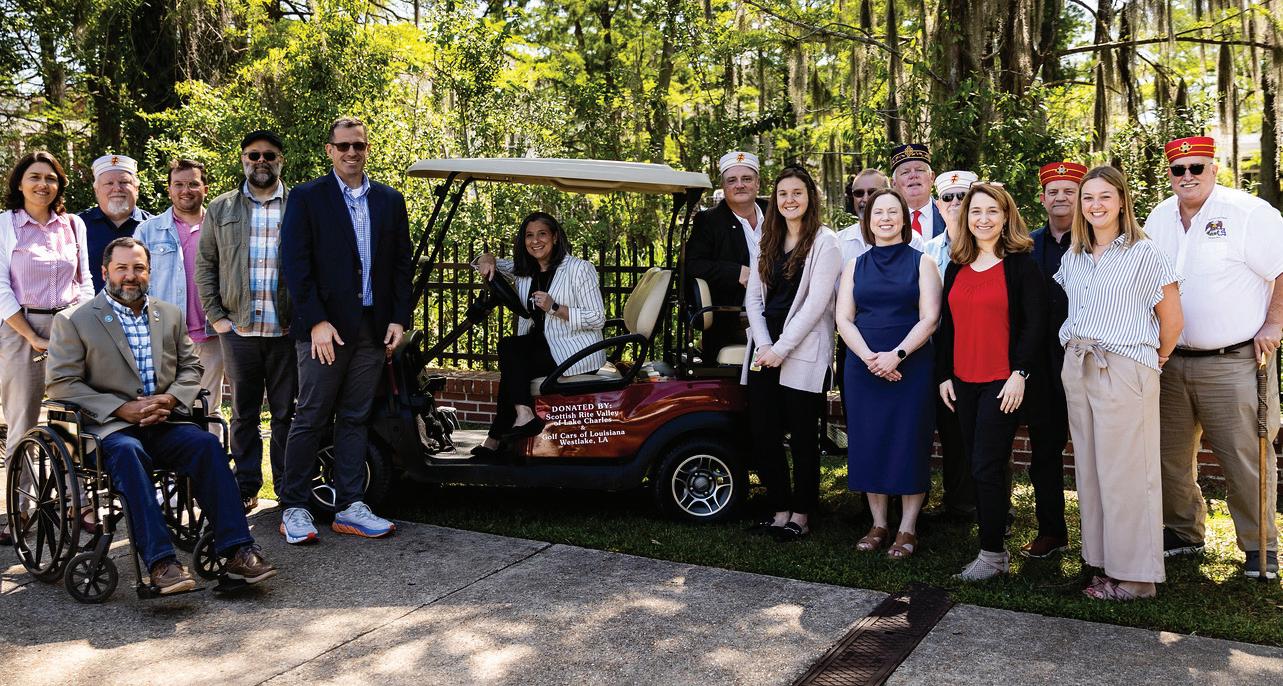
April 12, 2024,
The free, semi-annual online periodical Amicus Illuminismi (Friend of the Enlightenment) features articles representing four distinct House of the Temple departments: the Library, Archives, Museum, and the Scottish Rite Journal. In the Winter/Spring 2024 issue, the Library section presented its wide-ranging Taylor Collection of books from medicine to mysticism. Archives surveyed its photo collection of dedicated Masons, covering everyone from statesmen to a vintage movie star. Museum Curator Olivia Curcio introduced from the Temple’s newest Family of Freemasonry exhibit—a unique collection of Shriners whiskey decanters, noting that the exhibit and the decanter collection demonstrate “how ancient cultures and philanthropic ideals are celebrated in Freemasonry in both light-hearted and introspective ways.” The Journal section, which revives obscure treasures from its pages, offered an appreciation of “A Fable in Stone,” in which “The Rough Ashlar Speaks!” Enjoy exploring Amicus at https://scottishrite.org/our-museum/library/amicus-online/. • —Mark Dreisonstok, 33º, Managing Editor, Scottish Rite Journal

This fez-shaped Ezra Brooks decanter from the collection commemorates the 1976 U.S. Bicentennial. That year’s Shrine Imperial Session was held in Kansas City, Missouri.
Photography: Kia C. Boone
Want to read more of the Journal? Find it online at https://scottishrite.org, under the Education & Media tab.
Supreme Council recently awarded two Brothers with the Daniel D. Tompkins Medal for their committed service to their communities and the Masonic Fraternity at large.
Congratulations to both Brothers for their exceptional work!

Panos “Pete” Pitsas, 33°, MSA, Valleys of Nashua and Keene
Born in Karditsa, Greece, in March 1933, Illustrious Brother Panos (known as “Pete” by his Brothers) emigrated to the United States in 1948.
He enlisted in the U.S. Army and served as a paratrooper in the 101st Airborne Division for two years. He then attended Boston University, where he earned a bachelor’s degree in education and played NCAA Division I Soccer. He moved to Keene, New Hampshire, where he enjoyed a 33-year career as an educator. His love of sports and sense of community service included 57 years officiating five separate sports well into his 80s.
On January 22, 1961, Brother Panos married his sweetheart, Merope (Popey). Together, they raised four children and are
proud grandparents of five grandchildren. Illustrious Brother Panos’ service to Masonry is a story of steadfast reliability and mentorship. His Masonic journey began in 1972, receiving all three Blue Lodge degrees at Lodge of the Temple No. 88 in Keene, where he would later serve as Master in 1980. Panos played a vital role in the mergers of several Keene area lodges and the subsequent establishment of Jerusalem Lodge No. 104. He has served on several of the lodge’s committees and stepped up when the lodge needed a treasurer in 2022, a role he continues to serve in to ensure a smooth transition for his replacement.
In addition to his work participating and directing several Scottish Rite degrees, Brother Panos, 33°, is also actively engaged with the Shrine. A devout man, he regularly attends church where he has served on numerous committees within his church community as well.
“His greatest contributions to our Masonic Family are the grace and love he and Popey share as a couple, his humor, and his genuine desire to help others. Brother Pitsas actively engages as a Past Master and distinguished Scottish Rite Brother and is always there to lend advice, support initiatives, and develop Brothers into better Masons and men,” said Ill. Kenneth Clay, 33°, Deputy for New Hampshire.
Robert Voskoyan, 32°, HGA, Valley of Michigan
From patching holes in the parking lot of his lodge to organizing food and Christmas gift drives for his community, Brother Voskoyan embodies Scottish Rite’s Core Value of Service to Humanity. He cooks and brings meals to distressed Brothers during their time of need and has raised more than $1,000 a year for the Blue Lodge Fund. Brother Voskoyan has also spent countless hours taking veterans to the VA for care and helping them obtain the treatment and benefits they deserve.
As Worshipful Master of Monroe Lodge No. 27, Knights Templar commission chaplain, and Eminent Commander of Monroe Commandery No. 19, he has been instrumental in ensuring that all degree work in the Blue Lodge, York Rite, and Knights Templar are done within their lodge bodies.
“His dedication to duty and selfless sacrifice brings great credit upon himself, his lodge, and Freemasonry,” said Ill. Timothey Marshbanks, 33°, Deputy for Michigan.

On July 17, 2024, Supreme Council Deputy for Michigan Timothey Marshbanks, 33°, was pleased to present Brother Eldin Miller, 32°, with the Harry S. Truman Medal for Outstanding Citizenship for his leadership within his community and Freemasonry at large.
Brother Miller volunteers his time placing flags at cemeteries for veterans, in addition to collecting food, clothing, and funds for those in need. He is a volunteer firefighter and EMT, and he devotes his time to working with the Alzheimer’s Association, as well as a program that promotes childhood literacy.
In the Masonic world, Brother Miller works tirelessly to mentor other Brothers within the Blue Lodge and York Rite bodies to ensure they can begin to move up in the line, become better Masons, and get engaged right from the start.
“His exemplary accomplishments are in keeping with the finest traditions of Freemasonry and reflect great credit upon him and his community,” said Marshbanks.

The Supreme Council, NMJ held their 212th Annual Session in Lexington, Massachusetts on August 21-22, 2024.
At their session on Thursday, 136 candidates were elected to receive the 33rd degree. Added to the previous total, that makes a total of 232 candidates who will receive the degree in Indianapolis, Indiana, in 2025.
Supreme Council approved a new 24th degree, entitled, Brother of Tolerance, to replace the degree Brother of the Forest. The new degree echoes the theme of the previous version of the degree but with many historical inaccuracies removed. The new degree also contains only one scene, making it easier for Valleys to stage. Look for more information in the next issue of The Northern Light.
Ill. Robert J. Bateman, 33°, retired as Deputy for Pennsylvania and became an Active Emeritus Member.
Ill. Keith E. Parkinson, 33°, was named the new Deputy for Pennsylvania.
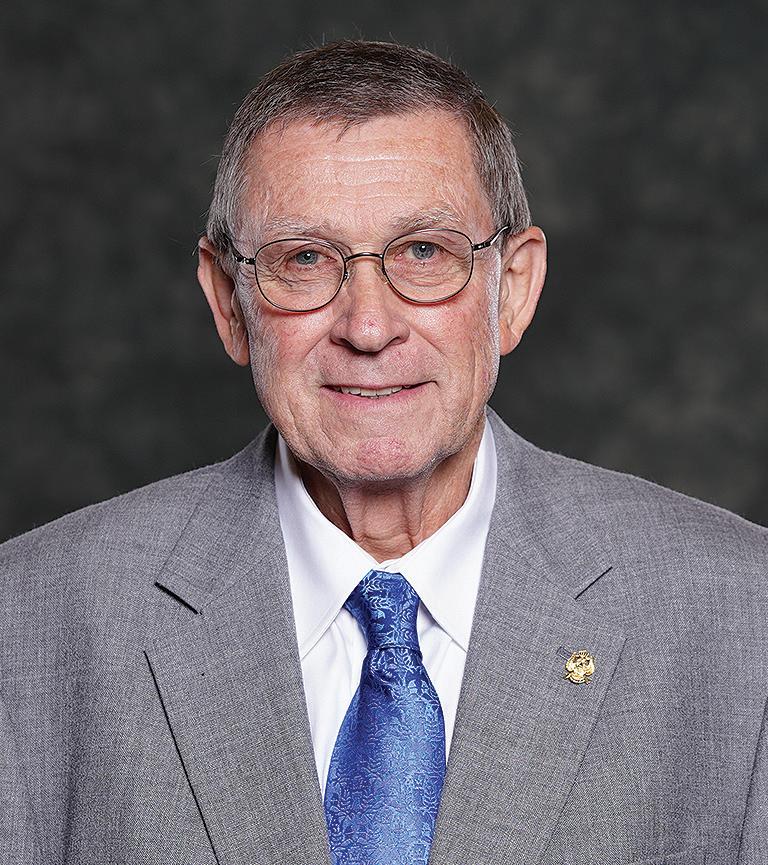

In June, Vermont Council of Deliberation recommended the consolidation of the Valleys of Burlington and Southern Vermont. At the Executive Session, the consolidation was approved. The new Valley will be known as the Valley of The Green Mountains.
In the late 1700s and early 1800s, performing elegant needlework was considered a valuable female accomplishment. Families with the financial means paid for girls to receive special tuition to study embroidery and other arts at private academies; some girls learned at home. Drawing on these skills, female family members sewed, painted, and embroidered Masonic aprons for fathers, brothers, and other relatives. Through the 1800s, most women had some expertise in the needle arts, be it dressmaking, plain sewing, or embroidery, to produce and maintain clothing and everyday textiles for their households. Other women drew on their sewing skills to work in the Masonic and fraternal regalia-making business, earning a living for themselves and supporting their families. Though women were barred from becoming members of Masonic lodges, over the decades, their work making aprons highlighted their abilities with a needle and displayed their knowledge of the Fraternity’s symbols and regalia.

Embroidered on silk, this luxurious apron with light blue trim was likely made by a female relative of its original owner. The apron’s design features an interpretation of the seal of the Grand Lodge of Massachusetts, suggesting that the apron may have been used by someone affiliated with that organization. The design of the Grand Lodge’s seal on this apron is the version used from 1752 through 1857. It featured a shield divided by a compasses on top of a square with two castles above and one below; the whole flanked by two beavers and accompanied by the motto “Follow Reason.” The embroiderer who created

this rendition of the seal formed the shape of the shield out of vines and flowers, a deviation from the standard design. Embroidery, botany, and flower painting were among the subjects taught to girls who received an academy education in the early 1800s. The maker of the apron appears to have deployed the skills she learned in school to create this handsome apron.
Speaker and author Jeremy Ladd Cross traveled throughout the United States to lecture to Masonic lodges in the 1810s. Based in New Haven, Connecticut,
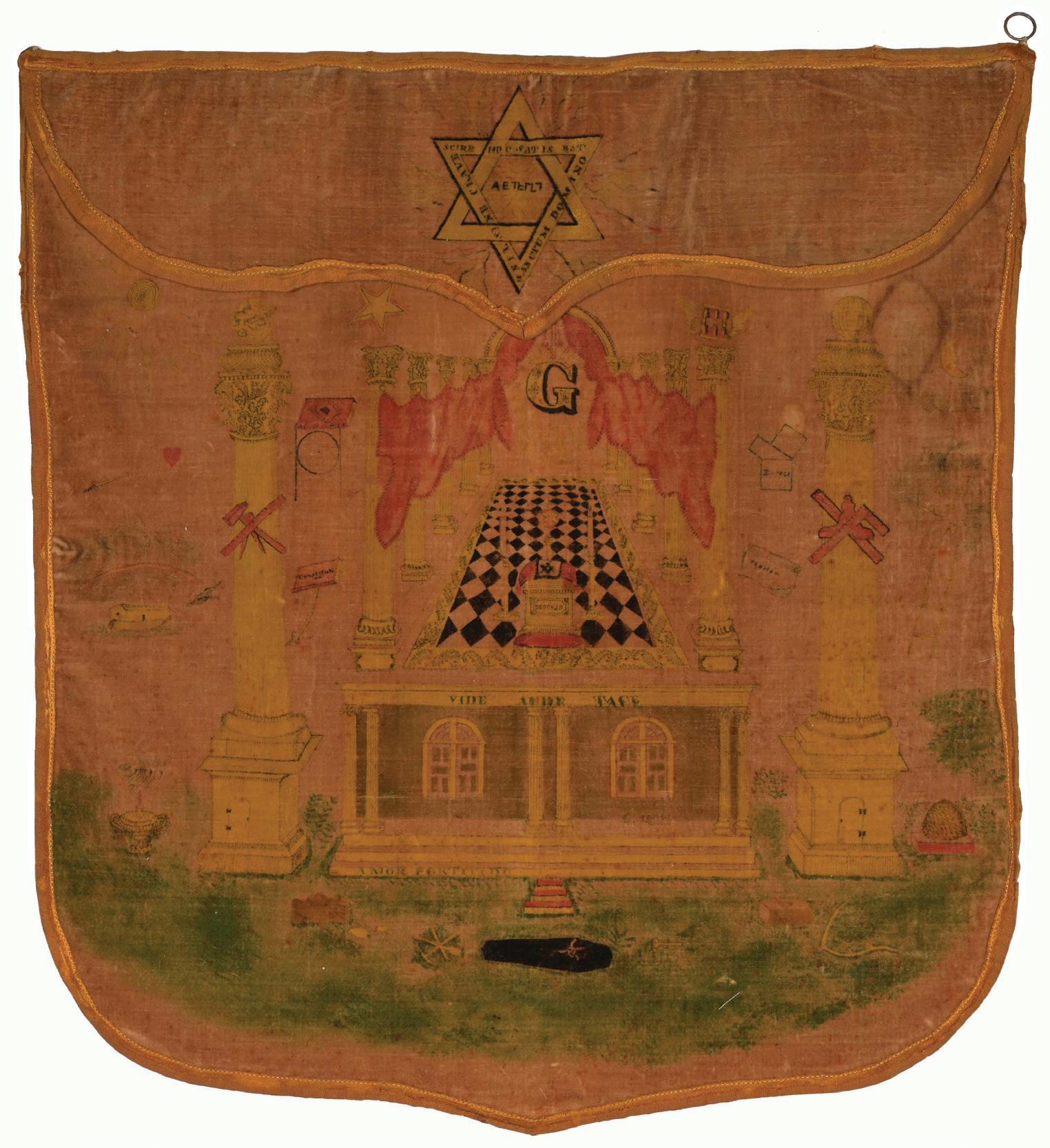

he offered aprons of his own design to members of the Masonic groups he visited. Cross produced this apron for the Select Master degree in conjunction with engraver and fellow Freemason, Amos Doolittle. The two men undertook the project as a joint business venture in which they, as Cross noted in his diary, “agreed to do and go halves in the expn & profit.” In his diary, Cross also recorded taking satin and other textiles to Doolittle’s daughter, Sarah. She likely sewed some of the aprons and regalia that Cross sold. Sarah Doolittle may have also handcolored some of her father’s engravings. Although there is no evidence that Sarah made up or painted this particular apron, she had the skills and experience to undertake this kind of work.
In 1826, Harriet Van Rensselaer signed the back of this apron, noting her name, adding the description “maker,” and recording the date and the community where she lived. Harriet resided in Chittenango, New York, with her husband, Philip Sanders Van Rensselaer, in the mid-1820s. In creating this apron, Harriet delineated Masonic symbols in ink and colored paint on velvet, a popular painting technique in the early 1800s. For design inspiration, Harriet drew on an apron designed by Giles Fonda Yates. Yates’ work was printed in Albany, New York, in 1821. She modified Yates’ richly detailed
design, changing the location of some elements and omitting others to suit her composition and the materials she used. Emblems she moved include those representing the constitutions and the charter. These symbols might not have been easily visible on her version of the black and white pavement at the center of the apron, so she shifted them to an area with a light background.
Other women relied on their knowledge of regalia-making and sewing skills to earn a living. A young widow with five small children, Ann Sisco took over her husband’s Baltimore, Maryland, fancy trimming company in 1846. It is likely that Sisco had assisted her husband with making regalia while he was running
work and the firm’s clientele. Ann Sisco advertised that she manufactured all kinds of regalia “suitable and appropriate to the different orders.”
In addition to Masonic, Odd Fellows, and Sons of Temperance regalia, she also sold banners, flags, and “Military Goods.” Two of her sons assumed management of the business after Ann Sisco retired around 1862.
Regalia maker and entrepreneur Rose Lipp manufactured this souvenir – in the shape of a Masonic apron – for a Knights Templar meeting. It doubled as an advertisement for her work.


On the back of the miniature apron, she noted her address, some of the Masonic items she produced, and called out that “Knights Templar Uniforms [are] a Specialty.” Rose Lipp started her business selling clothing-related regalia, such as aprons and sashes. Over time, she expanded her offerings to include uniforms, jewels, and swords. Though not a Freemason, Lipp was acknowledged “as an authority on correctness of design” of Masonic regalia. She operated her business in downtown Boston for over 30 years.
Regina LeFreniere Gordon of Raymond, New Hampshire, made and embroidered this and 10 other
If you would like to learn more about the collections in the Scottish Rite Masonic Museum & Library, visit our online collections database at https://www.srmml.org/collections/. ?

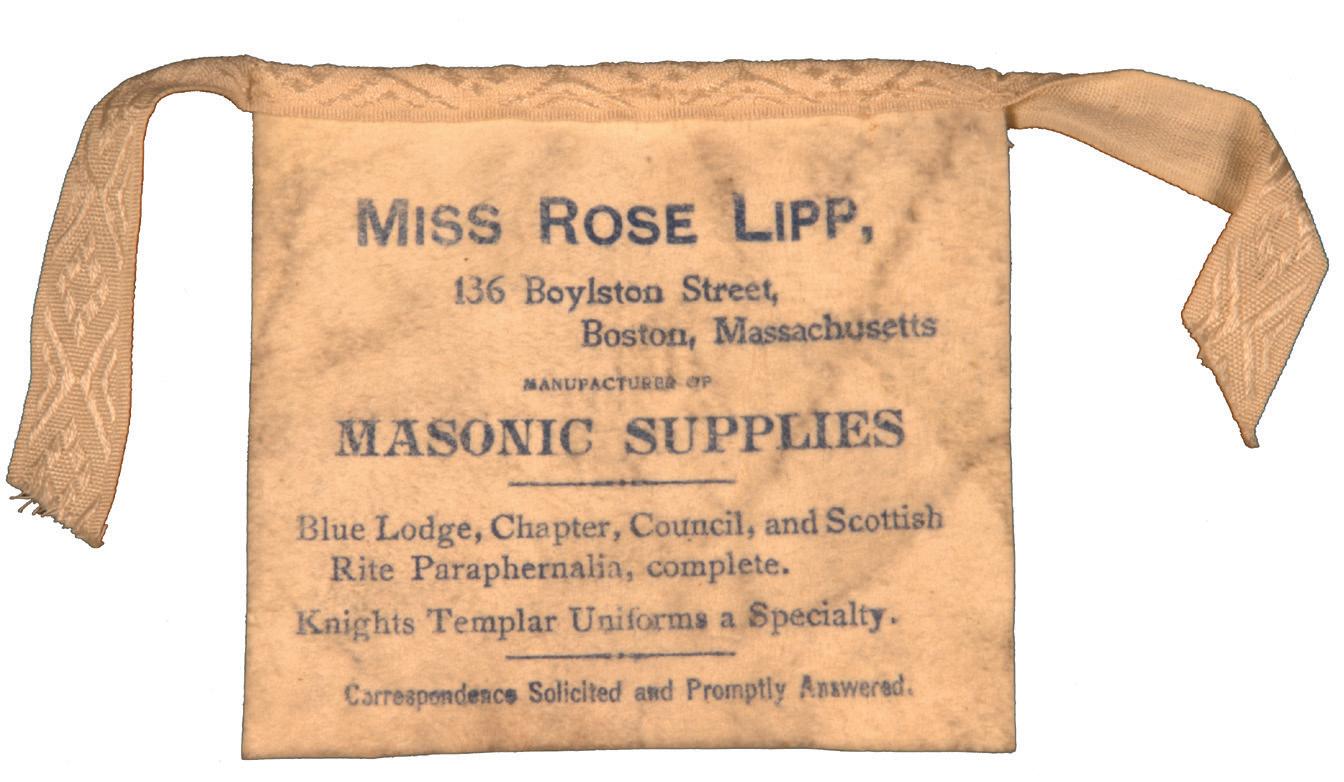
officers’ aprons for Tucker Lodge No. 99 in 1964. An expert in the needlearts, Regina Gordon was an adept quilter, embroider, dressmaker, and knitter. Tucker Lodge used the aprons she sewed and decorated for almost forty years. During this time, Regina Gordon’s husband, Josiah, and son, John, both served as masters of Tucker Lodge. Her work underscores how, well into the 20th century, women have deployed their skill with a needle to support and beautify the work of the Masonic lodges that were important to their families and communities.
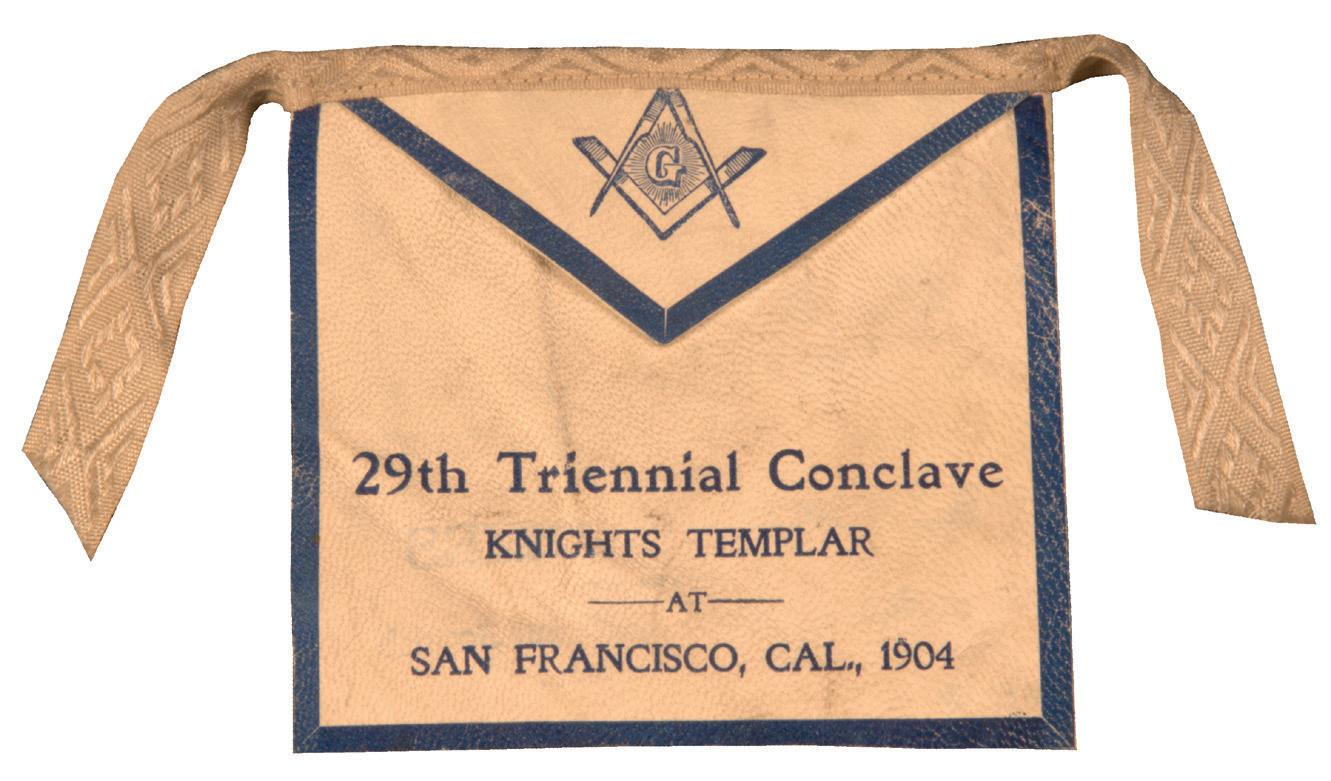
Apron, 1964. Regina LeFreniere Gordon, Raymond, New Hampshire. Gift of Tucker Lodge No. 99 F. & A. M., Raymond, New Hampshire, 2022.029.1. Photograph by Michael Cardinali.

In September 1916, at its Annual Meeting in Pittsburgh, Pennsylvania, the Supreme Council, 33rd degree, Northern Masonic Jurisdiction’s Committee on Rituals approved a major revision to the 32nd degree. Chiefly written by John Lloyd Thomas, 33°, of New York, the new ritual introduced the character of Constans to the degree. Just a few months later, in January 1917, the Philadelphia Consistory exemplified the revised degree for the first time.
The musical director for the Philadelphia Consistory, Gilbert Raynolds Combs, 33°, observed that “The Supreme Council having provided no music for the Ritual, it became the duty as well as the pleasure of the Musical Director [i.e., Combs] to prepare appropriate music.” Combs was well-suited for the task, having been born into a musical family – his father was a well-known musician and his mother a singer – and founding his own music school, Combs Broad Street Conservatory of Music, in Philadelphia in 1885. Because Combs’ pieces appealed to the Philadelphia Consistory, it officially adopted his compositions as the music it would use for the degree. In 1918, the Philadelphia Consistory published his music.
The Van Gorden-Williams Library & Archives holds a copy of Combs’ music for the 32nd degree. Our copy contains various notations and an ownership stamp in it. Our copy indicates that it was used by the organist for the Rhode Island Consistory and owned by Scottish Rite bodies in Providence, Rhode Island.
The markings show that Valleys outside of Philadelphia used Combs’ music. As you can see printed at the top left of the page, some of the verses of certain compositions were keyed to specific pages in the newly revised ritual text. Also visible on this page, the Providence
organist made pencil notations about this particular work.
Despite evidence of the music having been played as part of the 32nd degree in at least two states, it does not appear that Combs’ work ever received a stamp of approval from the Supreme Council’s Committee on Rituals. This may be because the committee had already engaged the services of another
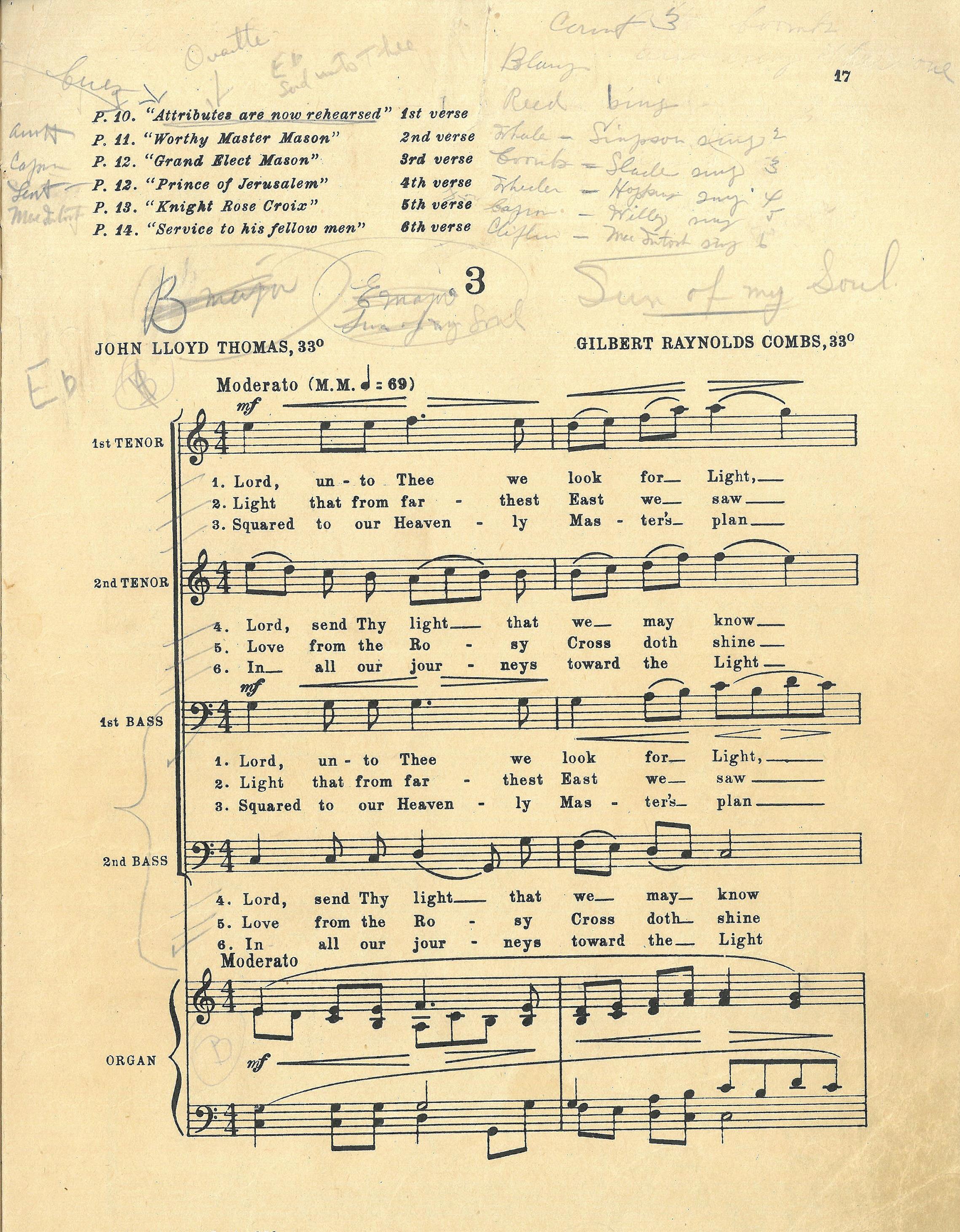
by Jeffrey Croteau, Director , Van Gorden-Williams Library and Archives
Scottish Rite Mason who, like Combs, was a professional composer. Before Combs’ work had been published, Daniel Protheroe, 32°, had written and arranged music for the 4th through 25th degrees. His compositions appeared in a series of three books published by the Supreme Council in 1909 and 1910. In 1918, the Supreme Council issued the fourth volume of Protheroe’s compositions and arrangements, written for the 26th to the 32nd
degrees. The Supreme Council’s 1919 Proceedings make it clear that Protheroe’s compositions for the 32nd degree were tied to the newly revised degree with this note: “We recommend the sum of $200.00 be paid to Dr. Daniel Protheroe as compensation for his services in the preparation of the music for the new 32nd Degree.”

The Van Gorden-Williams Library & Archives is located in Lexington, Massachusetts, at the Scottish Rite Masonic Museum & Library and is open to the public.
While it is unclear what impact Combs’ music had beyond Philadelphia and Providence, it is apparent that Protheroe’s music persisted as part of the Scottish Rite degrees well into the twentieth century. In the 1960s, the Committee on Rituals published a “Study of Music” report in the 1963 and 1967 Supreme Council Proceedings. In the 1967 report, the committee noted not only that Protheroe’s music was still being used in many Valleys half a century later but that Protheroe’s arrangements and compositions were “the only official music published by the Supreme Council [and] should not be discarded because they are old.” The Supreme Council continued to encourage the use of Protheroe’s music. In a series of booklets published in the 1960s and 1970s, Protheroe’s works are among those that the Supreme Council recommended to accompany various degrees. Combs name, on the other hand, is not mentioned at all.
Protheroe and Combs both died in 1934. Born just three years apart, these two Scottish Rite members were accomplished musicians outside of Freemasonry. They brought their musical talent and passion for enhancing the dramatic presentation of the Scottish Rite’s 32nd degree to their Brethren. Examining these works today, we can learn more about how the musical parts of the 32nd degree might have sounded over a century ago.
Have questions? Drop us a line at library@srmml.org or give us a call at 781-457-4109. ?

by Basilios E. (Bill) Tsingos, 32° Valley of Boston, Massachusetts


I chose the 28th degree because it dramatizes the Core Value of Integrity in the context of Rosicrucian ideas that gained currency in the century prior to the formation of the first Grand Lodge in London in 1717 and the emergence of modern Speculative Freemasonry.
The degree is set in 1650 in the secret headquarters of the Rosicrucian Order but is “not offered as historical fact, but as a dramatized symbolization of Masonry’s transformation from operative to speculative.” The Prologue explains that “[l]inks have often been sought between Rosicrucian[ism] and Freemasonry, but no connection between the two societies has ever been proven.” Rosicrucian adepts were drawn to alchemy as a way not just to “transmute base metals into gold” but, more importantly, “to improve the physical and moral health of humanity.” The degree explains that many men who were reputed to be Rosicrucians were also Masons, of which the “best known was Elias Ashmole who was made a Mason … in 1646.” Ashmole serves as “the personification of those men of goodwill, intellectual maturity, and fraternal spirit, who joined together to transmute an association of rude craftsmen into a powerful and enduring
instrument for moral instruction… men [who] were the builders of modern Freemasonry.”
“I now try to live according to this understanding.”
The 28th degree echoes other Masonic degrees that feature a search for that which has been lost, such as the Master Mason, Royal Arch, and Rose Croix degrees. It presents a series of aspirants who appear before the High Council to report on their progress in discovering ‘the secret’ that the Order seeks. The first, Johann, is sent on his way. He remains foolishly focused on the material world and mistakes the Order’s goal as being one of literally turning lead into gold. The second, Francois, explains that he has come to the realization that the mystique of alchemy and Rosicrucianism can be used to swindle the unsuspecting and extract money from the gullible. He, too, is sent on his way. The third, Inigo,
explains that the Order can exploit the allure of esoteric knowledge to manipulate others and thereby exercise power over the whole world. He, too, is sent away. Johann, Francois, and Inigo serve as personifications of the desert temptations of Jesus portrayed in the Gospels (see Matthew 4 and Luke 4).
If Integrity can be thought of as staying true to one’s Core Values and adhering to foundational principles even when it is inconvenient to do so in the face of temptation or duress, then Johann, Francois, and Inigo each fail their test of Integrity. Conversely, the Rosicrucian Brotherhood collectively passes its (first) trial. The Order does not let its commitment to spiritual truth be co-opted by substitute material quests for gold, riches, or power.
I am drawn to the parallels between the sacred narrative of these degrees and the steadfast faith that permeates our coastal life.
The degree proceeds from negative examples to provide a positive example of a man who possesses integrity. Elias Ashmole is the fourth aspirant to come before the High Council. He explains that he has come to the realization that “true alchemy is not performed on metals, but on the souls of men. I am the subject of God’s great work; it is my heart and soul which must be refined.” Ashmole explains that this knowledge is not to be directed outwardly to manipulate the material world or people around us but rather inwardly towards governing our own thoughts, words, and actions: “I now try to live according to this understanding.”
Ashmole’s realization resonates with truths emphasized in Masonic degrees. These include the four cardinal virtues presented in the Entered Apprentice
degree; the admonition to Fellowcrafts that virtue should be the rule and guide of your conduct in all your future transactions with mankind; and the Sword pointing to a Naked Heart, which the Master Mason is told teaches that our thoughts, words, and actions need to be tamed and made governable, because they are all subject to the scrutiny of that All-seeing Eye: God.
“Feel free to add your voice to our discussion of the failure of our Order to accomplish its aims.”
Odescalchi explains: “My Brothers, he has found the secret! He is worthy to be numbered among us. Let us welcome
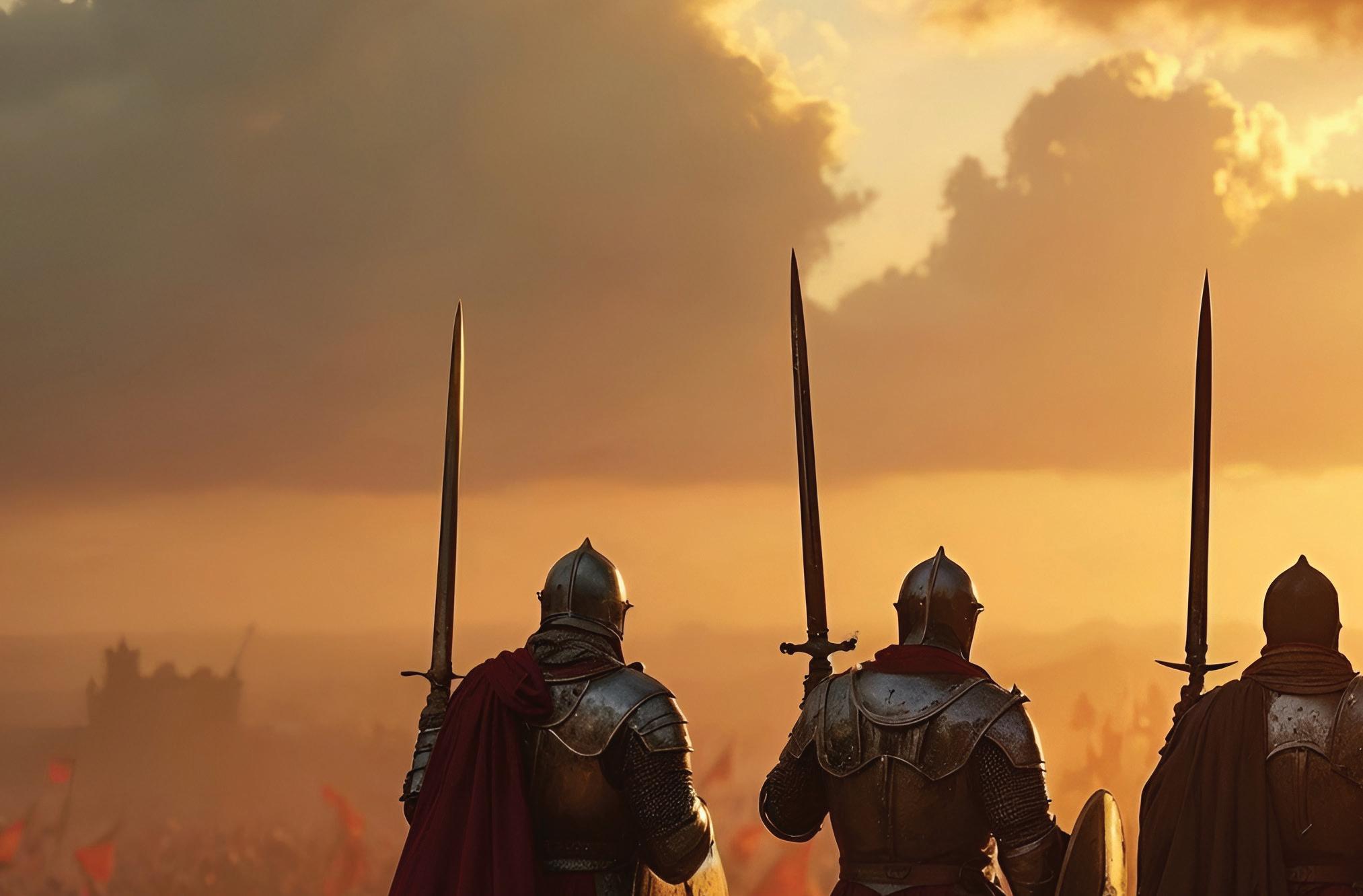
him into this High Council.” Ashmole is then invited to share with the High Council his views on why the Order has not been more successful in its mission, as represented by the failures of Johann, Francois, and Inigo: “You have seen the scoundrels and fools we too often attract. Feel free to add your voice to our discussion of the failure of our Order to accomplish its aims.” Ashmole presents a vision that is nothing short of a reimagining of Rosicrucianism—and will prove to be an ultimate test of the integrity of the entire Order. He explains, “We appeal only to the learned, the highborn, the rich who have the time and the learning to seek out the obscure and hidden meanings of our Art. But the hope of gold lures the unworthy.” Ashmole argues that the Order needs to transmute not gold but itself. The
Order needs to radically change how it engages the world and makes its eternal truths known. He suggests that our hidden concepts should be represented by more familiar emblems, offering that the tools of a builder might be more accessible.
“...virtue should be the rule and guide of your conduct in all your future transactions with mankind...”
The 28th degree thus presents vital lessons about individual and group integrity. Ashmole presents an existential challenge to the Order. Is it, and are its members willing to transform themselves and become
To learn more about HGA and sign up for the waitlist, visit ScottishRiteNMJ.org/ hauts-grades-academy !
something new? Are they willing to yield to the realization that, if they are to be true to their spiritual goal, they need to figuratively die and be reborn, phoenixlike, in the guise of Speculative Freemasonry? The degree suggests that the transmutation that gave us Speculative Freemasonry would not have been possible without the transcendence of ego and the integrity exhibited by men like Ashmole. It is not the first time that the growth of one movement has necessitated the decline of an earlier forerunner. As that paragon of integrity, Saint John the Baptist, memorably put it to his disciples in explaining in John 3:30 why they must leave him and follow Jesus: “He must increase, but I must decrease.”
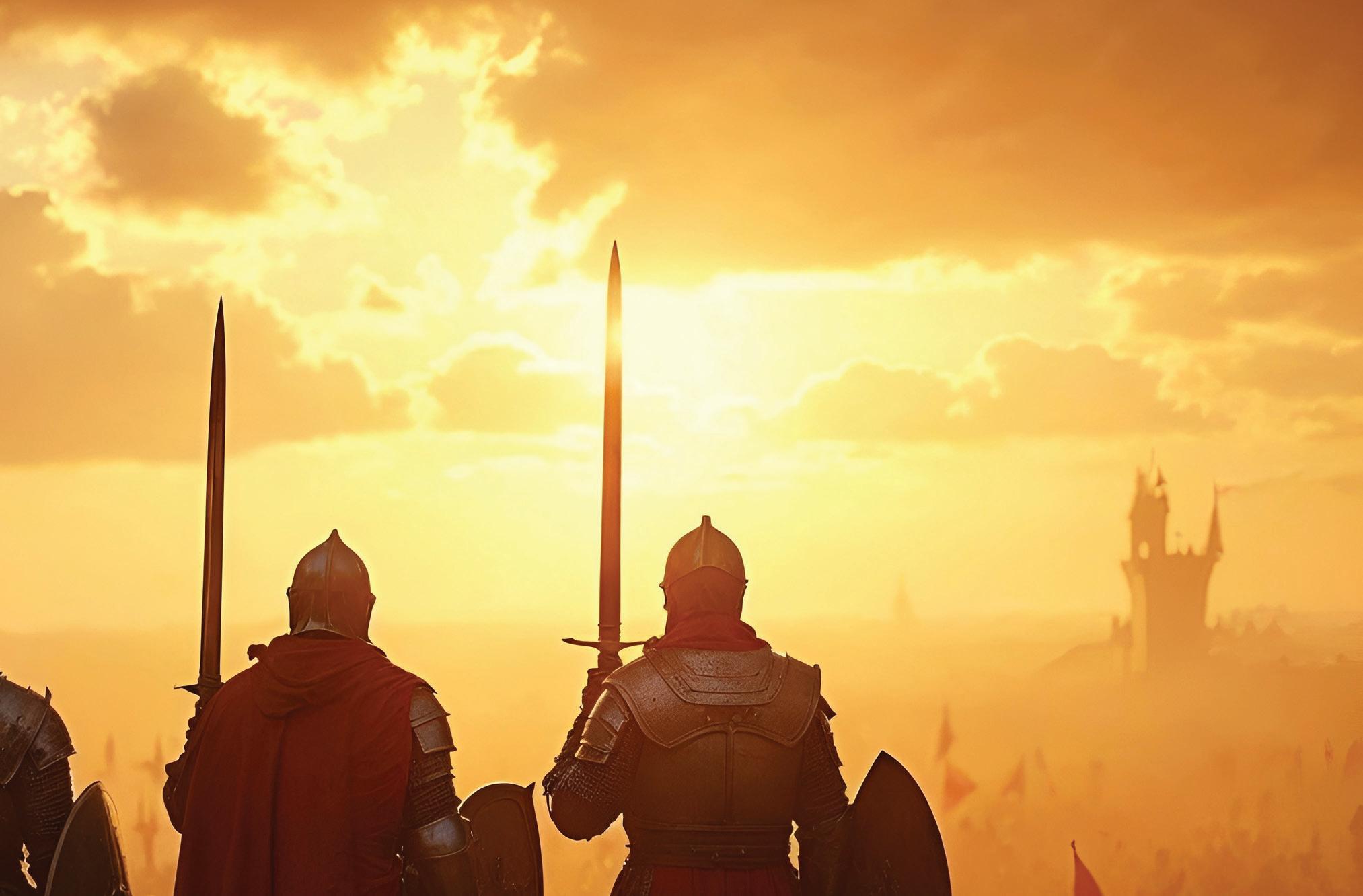
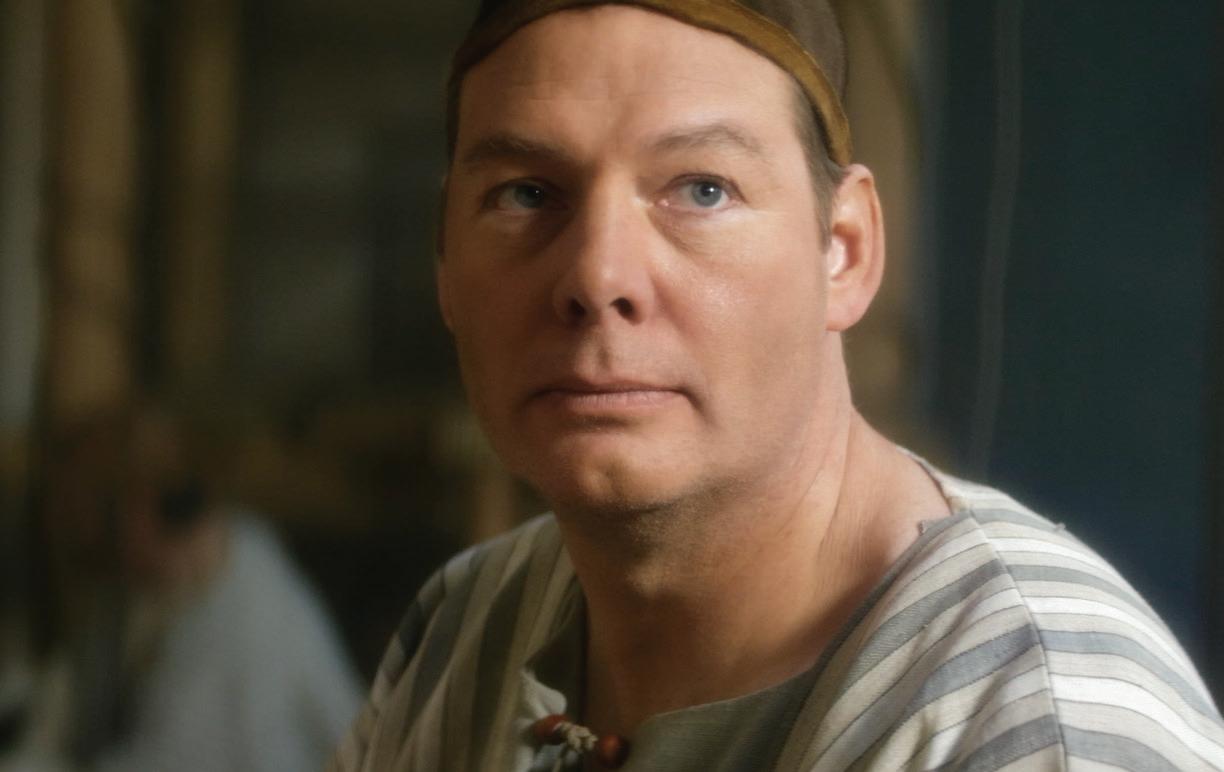
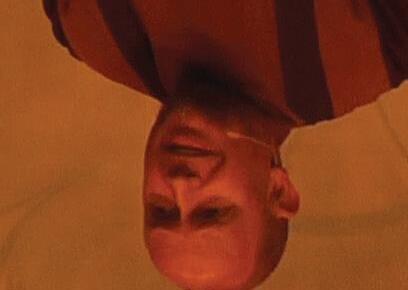
by James W. D’Acosta, 32° Valley of Bridgeport
Scottish Rite in 2006, my first round through our degrees was before the film era. My second, completed in 2023, exposed me to the spectacular films that are now available. This second round taught me that different formats alter a degree’s lessons.
The film of the 4th degree, Builder, is a perpetual gift. In it, I watch craftsmen use setting mauls on the construction site of the Temple of Solomon. My uncle Wade made the setting maul I used to regulate lodge meetings during my tenure as Worshipful Master. Its heft, form, and commanding “bang” led me to gift similar ones to my officers. The film gave me both a better understanding and appreciation of this implement.
Experiencing the 4th degree live in September for the first time in many years provoked different thoughts. The Prologue by Guy Whelchel was more robust and more appealing than in the film. Brother Whelchel stepped from the stage in the Valley of Bridgeport’s Leo H. Lorman II Theater to face the candidates sitting in the first row. He commanded each man’s concentrated attention.
Walter Matis alerted me to the power of actors to imbue performances with varying meanings. Each time they perform, they can use nuances of motion, tone of voice, and movement to alter meanings. There is a script. The same words are spoken in one performance as in the next (as well as in the films), but each portrayal is stamped with the interpretation of the actor and is unique. Brother Whelchel customarily moves out of the



The same words are spoken in one performance as in the next (as well as in the films), but each portrayal is stamped with the interpretation of the actor and is unique.
stage’s performance space and into the personal space of each candidate.
For example, in my first viewing of the 14th degree, Grand Elect Mason, the actor portraying the principal character portrayed his part in a way that struck me as overtly Christian. In my second viewing of this culminating degree of the Lodge of Perfection, Brother Whelchel, as Thrice Potent Master, having descended the stage, used a commanding tone and louder voice. Through eleven repetitions, everyone in the theater understood the new meaning of communion: All men are brothers under the fatherhood of God. All men, ALL men, period.
The impact of a larger-than-life image projected onto a screen stretching across the breadth of a stage strikes a haunting blow in the film of the 6th degree, Master of the Brazen Serpent. Here is Yahweh, the confrontational and severe God of the Jews. Rebels are killed by black venomous snakes which fill the screen as instruments of His divine judgment. Punishment and death dominate memory.
This visual sequence competes with the facial expressions and voice modulations of the character who recounts God’s merciful actions. But the graphic killing of the rebel leaders overwhelms these verbal reminders of God’s lovingkindness.
The impact of a larger-than-life image projected onto a screen stretching across the breadth of a stage strikes a haunting blow...
Troubled, I checked my notes from last seeing the 6th degree live in 2010. From the live performance, I concluded that God would surely help me through periods of anguish and doubt, as he liberated the Jews from slavery and guided
them to the promised land. The killing of the apostates had not overwhelmed this message of grace and support.
Beyond displaying the operative use of a trowel or other prop, films have unreachable capacities to educate beyond that of the stage. The film of the Lodge of Perfection’s 11th degree, Sublime Master Elected, as well as that of other degrees including the Consistory’s 27th degree, Knight of Jerusalem, show the geography and vastness of the Middle East and orient viewers firmly in the setting of the Holy Land.
A hybrid of film and live performance takes place when images are projected on the screen while the degree is

The eyes tell the mind, “Thousands of manhours must have gone into making that! Behold the materials, the craftsmanship!”

portrayed live just in front of it. For example, the computer-generated model of Herod’s Temple spread across the screen in the Chapter of Rose Croix’s 17th degree, Knight of the East and West, fills the viewer’s senses with the splendor of the House of God which is impossible to accomplish with props and verbal descriptions. The eyes tell the mind, “Thousands of man-hours must have gone into making that! Behold the materials, the craftsmanship!”
Another factor in weighing the advantages and disadvantages of the mediums chosen for our degrees impressed itself upon me during the Valley of New Haven’s live performance of this degree in 2018. Bob Furce, serving as Master of Ceremonies, was asked to recruit the cast of more than 100 Brothers as part of his education in the skills necessary for higher office. And this time, the Valley further augmented the 17th degree by spreading the action throughout Connecticut’s largest lodge room.
Mobs of passionate Essenes, Pharisees, and Sadducees came to Herod’s Court demanding satisfaction, entered the room from all directions, and filled the lodge space in front of Herod’s court on stage. The physical proximity, movement, shouting, and fists raised in anger brought the entire audience into the drama of a riot narrowly averted.
The size of the cast imprinted itself on my mind as in my inaugural Entered Apprentice degree when realizing that all these men were exerting time and energy for me. This is humbling in Blue Lodge and stunning in Scottish Rite. The effort of individual Brothers to rehearse and perform on behalf of candidates is a richness of Masonry as we strive to help each other to become better men.
In this instance, the audience glimpsed the Pathfinder program’s lesson that
participating in live performances enriches Brotherhood and deepens understanding of moral lessons as costumes are donned and lines memorized.
Film versus live? Each medium educates viewers more or less effectively about the degree’s historical setting and at times impresses different lessons upon the viewer’s memory. Furthermore, live performances are unique while those which are filmed are static. Repeated viewings clarify and enrich our understanding of degrees.


by PJ Roup,
Oak Island and its rumored stash of loot have been an obsession of fortune hunters and mystery seekers for more than 200 years. This tiny island off the coast of Nova Scotia first came to prominence in the late 1700s when a local boy happened upon an unusual depression in the ground. He and his friends excavated the site, later nicknamed the Money Pit, and discovered it to be a man-made shaft descending nearly 100 feet into the earth. Since then, the stories have been told of Captain Kidd’s loot, Marie Antoinette’s jewels, and, of course, the Knights Templar treasure being hidden somewhere on the island.
Thesetales and the promise of such a discovery have captivated the attention of thousands who have wished to solve the mystery once and for all. Two such men are Corjan Mol and Brother Christopher Morford, 32°, coauthors of The Jerusalem Files: The Secret Journey of the Menorah to Oak Island.
Now a restauranteur in Hilton Head, South Carolina, Chris was born and raised in Chicago. “I used to go to school downtown Chicago and pass by the Scottish Rite Valley of Chicago Cathedral,” Chris recalled. “I always wondered, ‘What are they doing in there?’ So, I had the nerve to knock on the door one day, and that started my journey.” He took his Blue Lodge degrees in Oriental Lodge No. 33 and soon after joined the Scottish Rite Valley of Chicago.
Oak Island initially attracted his attention through the show In Search

but it’s on his radar. His home is near the city of Maastricht, near one of the country’s oldest lodges. “I was always interested in the concept of Freemasonry but never got around to knock on the door and see what was inside,” he said. “Fortunately, The Jerusalem Files gave me the opportunity to do some presentations in the lodge. So, by now, I’ve set a few steps inside and met some amazing people.”

Of, starring Leonard Nimoy. His interest had waned until a friend, Chris Donah, appeared on the History Channel’s hit show, The Curse of Oak Island. “I binged all of the episodes and started coming up with my own theory. [My friend Chris] said, ‘Go ahead, send it to the show. What could it hurt?’ And I did. A week later, I got a phone call from the crew, and they flew me out there. And that’s how I met Corjan.”
Corjan is a 52-year-old financial services consultant from the Netherlands. He is not a Mason (yet),
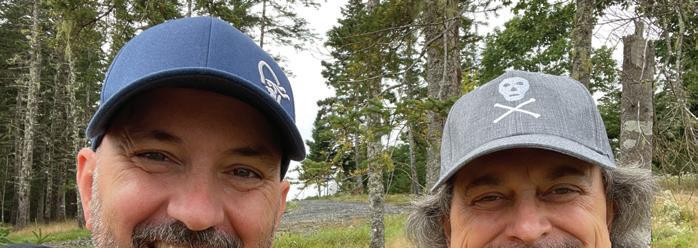

Corjan was working on a theory called the Mystery of Rennes-le-Chateau, the backstory of the hit novel The Da Vinci Code. “I did some research into that, started a podcast, a website, and then I was approached by the BBC to join in a documentary,” he said.
That documentary eventually led to his being asked to work on The Curse of Oak Island, where the production staff connected the two of them.
“I binged all of the episodes and started coming up with my own theory.”
“They encouraged us to work together because our ideas, our personalities, our theories kind of dovetailed,” Chris said. “It turned into a great friendship and a research partnership.”
Both of their theories centered on the 17th-century French painter Nicolas Poussin. “We came from completely different sides,” Corjan said, “but

when we added things up, things appeared to be a bit more interesting than I had anticipated.”
“A bit more interesting” doesn’t even begin to cover it. The Jerusalem Files takes the reader on a journey that literally spans the globe and covers centuries of art, science, and intrigue, eventually leading us all the way to Washington, D.C., and the Pentagon.
“If you zoom out,” Corjan said, “the synopsis of the book is that the order of the Knights Templar was founded by the Church of Rome, with a specific purpose to find something under the Temple Mount in Jerusalem.” But just what were they searching for?
When they met, both Corjan and Chris were studying Poussin’s painting, “The Shepherds of Arcadia,” for a connection to Oak Island. Their research led them to a monument with a bas-relief engraving of the same painting surrounded by a Latin poem by Horace but with a word changed.
“But why did a word have to be changed in what many consider to be a perfect classical text? So, we started to look further into the painting,” Corjan said.
“Shepherds of Arcadia” is based on a pentagram. Poussin arranged the subjects in the form of a pentagram which is positioned partially outside
the frame of the painting, and he used that to make his composition. When they outlined a pentagram over the painting, they discovered that it intersected seven letters in the inscription which spelled the word menorah. Not only that, but mirrored on the other side of the monument, the same projection intersected the same letters in an entirely different inscription. Was the treasure the original seven-armed menorah of Moses from the first Temple of Solomon?
“Now, we knew that could be coincidence. But I think we both lost a night’s sleep over this, because the coincidence is uncanny,” Corjan said.
More clues in the monument led them both to Versailles as well as to Louis IX of France and his connection to a number of cathedrals, among them the Cathedral of Chartres, famous for its labyrinth. It turned out that there are five prominent cathedrals in France containing labyrinths that form a pentagram pointing almost directly to Oak Island. Even more uncanny is that when viewed from above, each of the labyrinths resembles a mirrored seven-armed menorah!
“They encouraged us to work together because our ideas, our personalities, our theories kind of dovetailed,”
“We looked at Versailles because we had found this clue on this monument in England,” Corjan said. “And we saw that if you look at Versailles from the

air, you see a seven-armed menorah laid out in the garden paths.”
Chris and Corjan are fascinated by the utter brilliance and esoteric beauty of the Versailles menorah.
Louis IX left Acre for France on April 25, 1254. It was not only his 40th birthday but also Easter.
Throughout each year, the “lamps” of the Versailles menorah are lit one
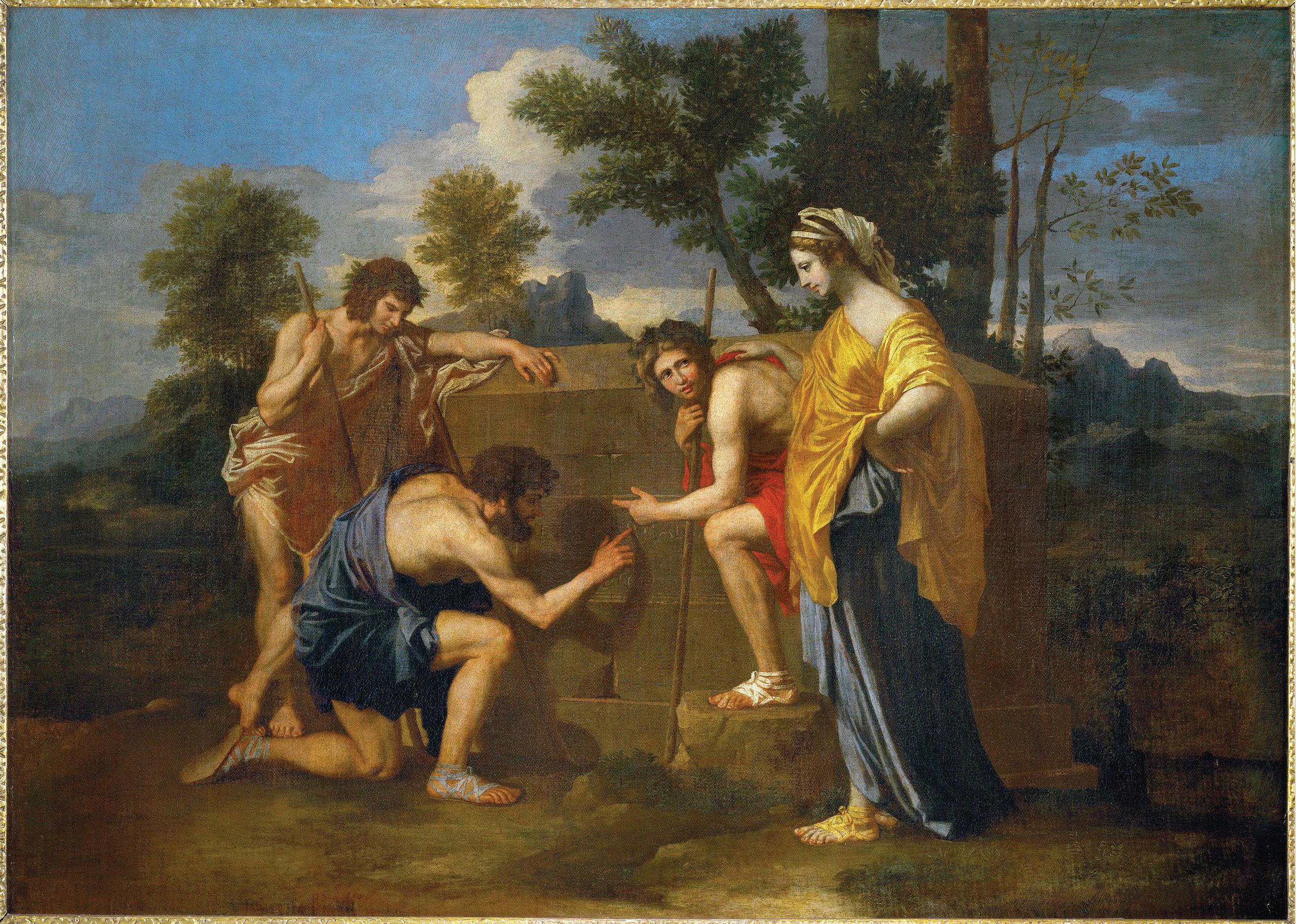
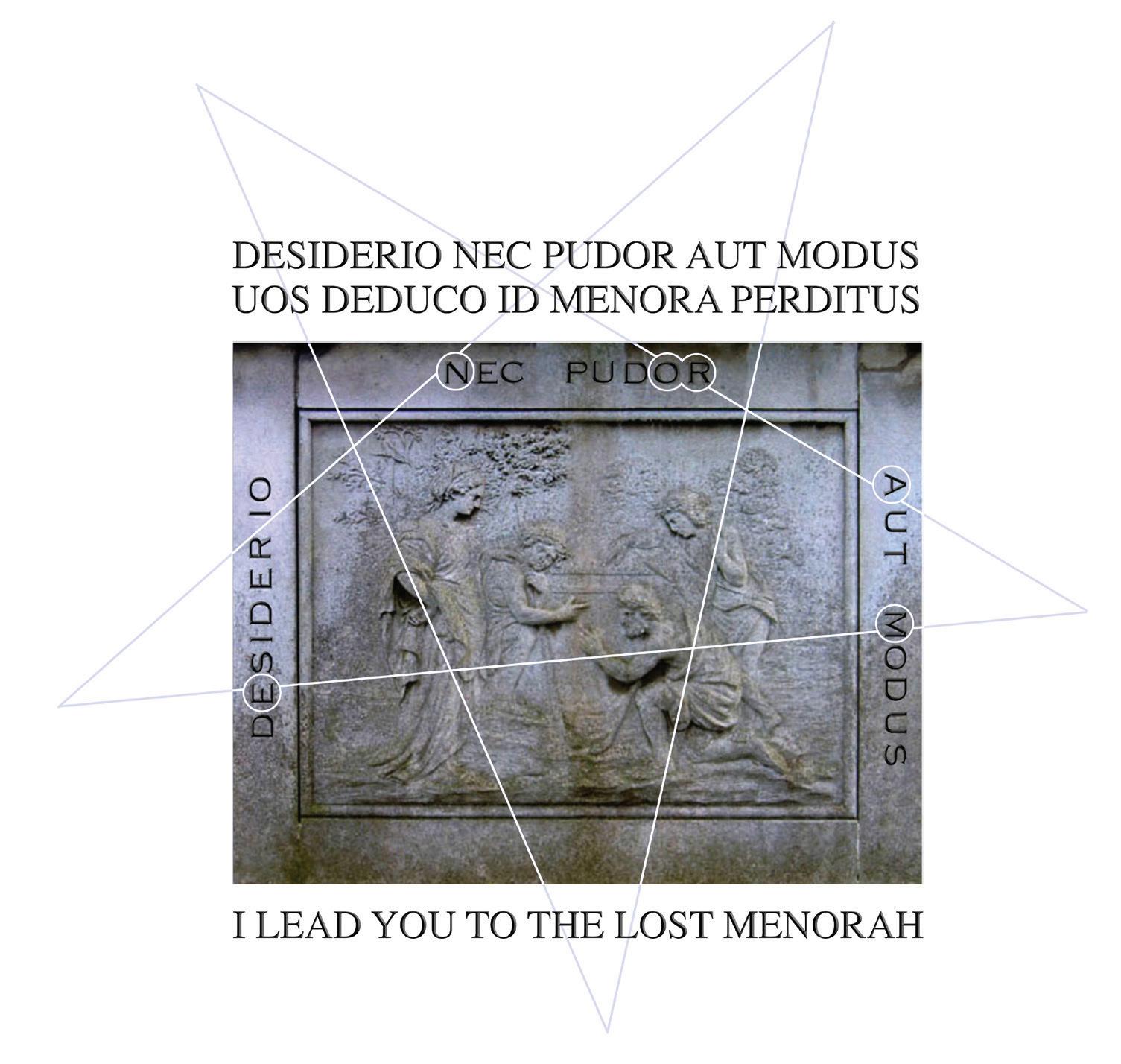
by one by the setting sun as the months progress because of the sun’s movement through the sky. However, the most special day is April 25, when the sun sets exactly in the middle of the central candle, lighting the path to Jerusalem and North America.
Space does not permit me to cover all of the well-thought-out and meticulously researched connections, and doing so would take all the fun out of reading this captivating book, but I can’t end this without making a connection to the Freemasons, right?
“So one of the most famous treasure hunters on Oak Island,” Chris said, “was Franklin Delano Roosevelt. So we are keenly interested in FDR and his Masonic ties and what his real interest would have been in Oak Island.”
A lot of what led them along their journey was the pentagram. “Well, we couldn’t help but notice that the largest pentagram in the world sat in Washington, D.C. – the Pentagon, which was built by FDR,” said Chris. “At the time, his military advisors and others said, ‘Please don’t build it in that swamp over there.’”

He continued, “It was the largest building at the time. It was going to be a bit difficult. Could they have put it somewhere else, or could we even do separate buildings? Because they essentially created the largest bullseye to house the military in. We theorize that perhaps Roosevelt was able to recover some of these treasures from Oak Island. And aside from building a military complex, which extends several floors below the earth…what an ideal place that might be to secure some treasures,” he posited.
You never know, right?
“We did our very, very best to back up what we’re saying and provide all those footnotes. If we were speculating, we made that clear. We don’t want to mislead anybody,” Corjan said. “For the other parts, people can research it. They can go right to our notes and look it up themselves. Every document that we discuss – also the original sources mentioning the Knights Templar – is available either online or in the work of other researchers and people.”
The Jerusalem Files is a compelling read filled with footnotes, illustrations, and an elaborate timeline that begins in 1099 and ends with the building

Beyond the Quarry: Labors of Love
Do you have an interesting hobby, event, or recreational activity that you would like to share with us? If so, contact editor@srnmj.org and let us know about it. You just might find yourself featured in a coming issue.

of the Pentagon in 1941. Some of the theories will leave you thinking, There is no way it could be true, but a few paragraphs later, you’re back on board. “You can check all the facts,” Corjan said. “Whether you subscribe to the conclusions, of course, is up to you. But we have a firm belief that we’re on the right track here.”

We may never really know, and perhaps that is one of the most compelling aspects of the mysteries surrounding Oak Island. There are so many people, places, and events that can be connected, so many conclusions drawn. The threads that connect those things form an intricate fabric that has captivated the imagination of so many for so long. Perhaps someday, the mystery will be revealed. Until then, the theories will have to do.
If you walk east from the U.S. Capitol building today you are essentially walking through Versailles, as the layouts for the most part are identical. However, L’Enfant added several improvements to his Washington plan.
L’Enfant’s final design is incredibly significant to our story because it means that the giant menorah which can be seen laid out in the gardens of Versailles is also present in the street plan of the city of Washington. This results in two giant menorahs, one on either side of the Atlantic (below). The U.S. Capitol building itself corresponds with Louis XIV’s palace, while the central lamp of the Versailles menorah corresponds with the circular Robert F. Kennedy Memorial Stadium. The two smallest arms closest to the central lamp of the landscape menorah at Versailles were replaced by two much longer arms in Washington, extending from the Capitol along Maryland Avenue NE and Pennsylvania Avenue S.E.
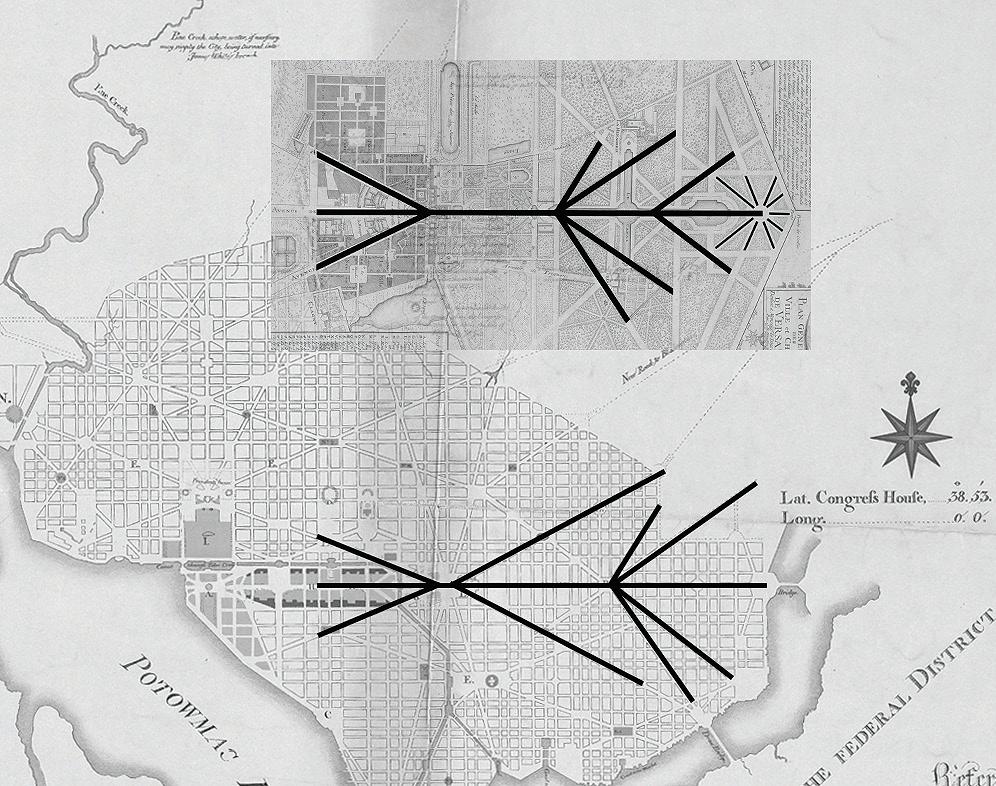
labyrinths
Regardless of these small adjustments, L’Enfant had not only rebuilt Versailles on the Potomac but he had also brought the menorah over to America.
Supreme Council’s Valley of Excellence Program is a special distinction designed to recognize Valleys in the Scottish Rite, Northern Masonic Jurisdiction, who go above and beyond. With focuses on areas of membership, service/ philanthropy, leadership development, and operations, this program encourages Valleys to deliver a premier Scottish Rite experience.
Out of 97 total Valleys, we are pleased to announce that 40 Valleys achieved Valley of Excellence status for the census year beginning June 16, 2023, and ending June 15, 2024. In addition, five Valleys attained a perfect score of 105!
The 2023-2024 Valleys of Excellence and their respective scores are:
by Joann Williams-Hoxha Content Manager
In the census year ending June 16, 2024, 270 members joined the Scottish Rite, NMJ through a Join the Rite Night event, and 63 out of our 97 Valleys had at least one member join through a Join the Rite Night. In addition, 68 out of 97 Valleys held a Rite on the Road event to bring in members.
Valley contributions for Grand Almoner’s donations totaled $183,000. In addition, Valleys donated $512,000 championing various charities of their choice. For the Blue Envelope appeal, 45 out of 97 Valleys reached or surpassed their goal.
LEADERSHIP DEVELOPMENT
With the release of Supreme Council’s new book, The Path Forward: Empowering the Future of Freemasonry, Valleys of Excellence leveraged key insights from our study to ensure Scottish Rite, NMJ continues to appeal to the modern man. Fostering the growth of Valley leaders through ambassador and mentoring programs, in addition to educational programming like Hauts Grades Academy and Pathfinder, proved to be a recipe for sustained Valley of Excellence success.
“A massive congratulations to all our Valleys of Excellence this year. Achieving VOE status is no small feat, and your tireless work does not go unnoticed,” said Bob Kefalas, 32°, Senior Director of Member Services and Programs.

For the last 20 years or so, stories have been circulating among Freemasons and the general public that the Scottish Rite Cathedral in New Castle, PA, is haunted.

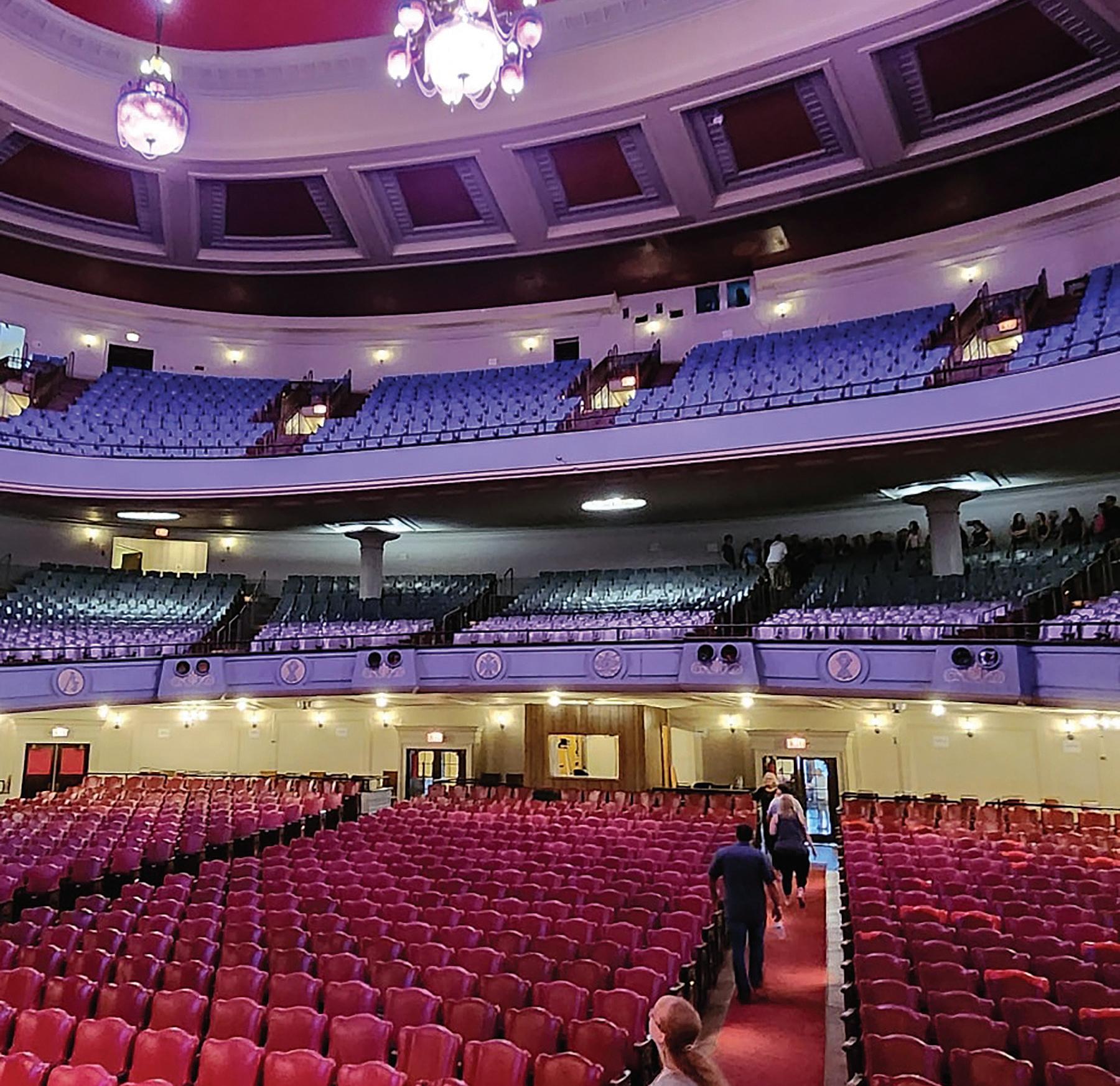
From sightings of apparitions to disembodied voices, Brothers from the Valley of New Castle decided to hold a public “ghost night” at the Cathedral to help raise money for the Western Pennsylvania Children’s Dyslexia Center (CDC), which also has space within the building. The spooky evening, which went well into the morning, surpassed their expectations –raising over $6,000 for the local Center.
The Scottish Rite Cathedral, located at 110 E. Lincoln Ave in New Castle, Pennsylvania, has many reports of possible paranormal activity, from Scottish Rite Brothers to volunteers, and the public at large. From unexplained whistling and voices to phantom smells of cigar smoke and cold spots, the accounts of strange occurrences are enough to fill a whole night of storytelling around a campfire.
Scottish Rite Brothers came up with the idea of the guided ghost tours as a unique fundraiser to introduce the public to the 100-year-old building and show people the areas where first-hand reports of paranormal activity have been experienced throughout the years.
“We were kind of flying by the seats of our pants, hoping to have 100 people show up,” said Brother John McCormick, 32°, Deputy Master for New Castle’s Lodge of Perfection. The summertime event, which took place from 6 p.m. to 6 a.m., ended up bringing in more than 400 paranormal enthusiasts and history buffs.
The event served as a combined Masonic family affair, with the Rainbow Girls
by Joann Williams-Hoxha, Content Manager
manning the concession stand, Blue Lodge Brothers opening up their lodge to the public for the first time, and Cathedral Foundation and CDC volunteers all lending a helping hand.
“It was a bit of a hurdle. But we need to think outside of the box. It was a big learning experience for everyone,” Brother McCormick said.

For some, the event opened their eyes to more than a successful fundraiser. McCormick said several Brothers are convinced that the spirit of a past Secretary still visits, as witnesses saw a ghost standing by the Secretary’s desk in the West Lodge Room on June 25th. There are also reports of a male apparition wearing a top hat, so it could be a Past Master. The stories from Valley members alone are abundant.
McCormick reported that during the ghost night, one group had a “little talk box” in the Blue Lodge that kept saying, ‘Leave. You don’t belong here. Get out.’” The talk box, also known as an SB7 spirit box, sweeps through AM and FM radio frequencies forward or backward. The theory is that spirits use the radio and white noise to communicate.
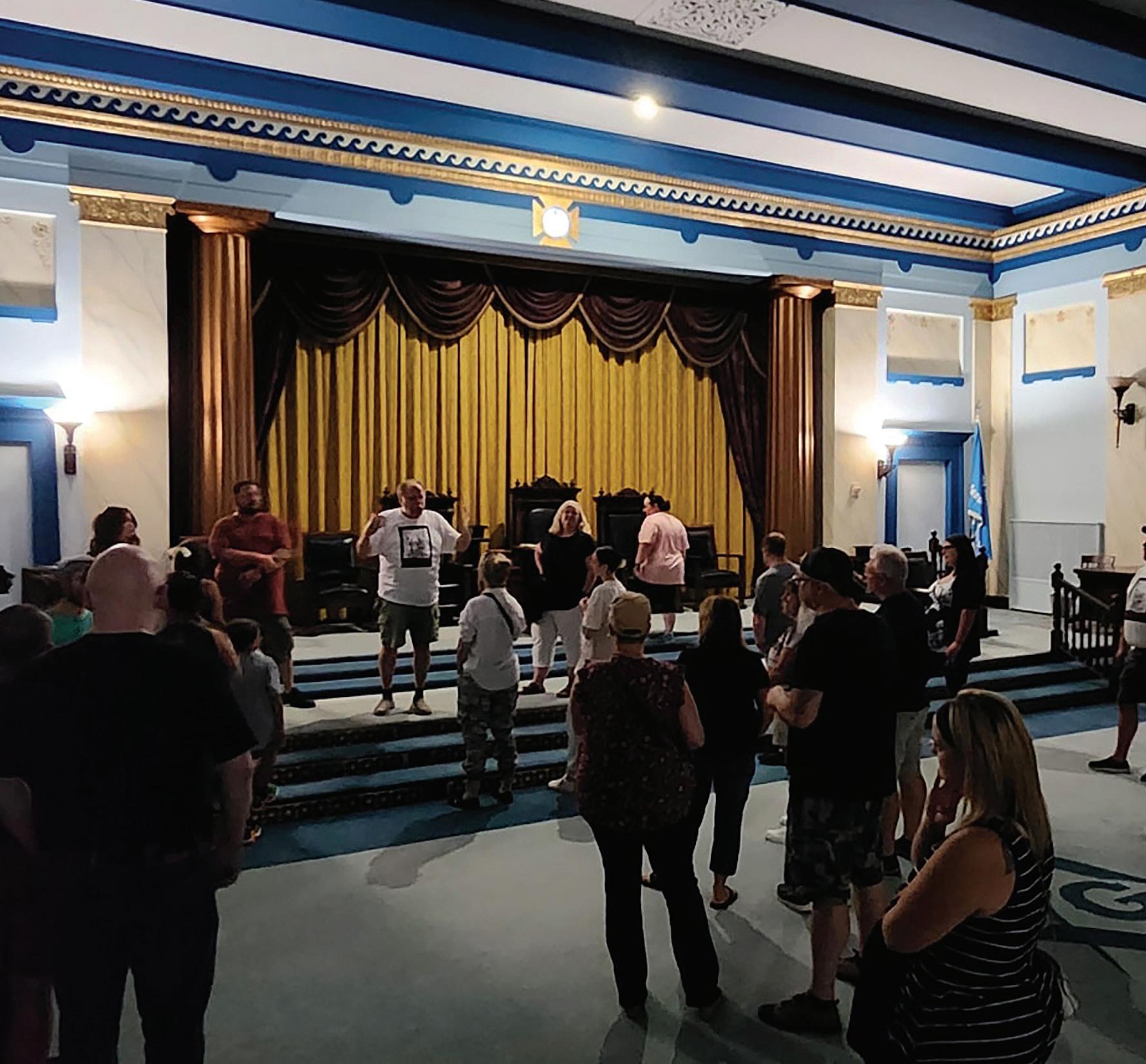
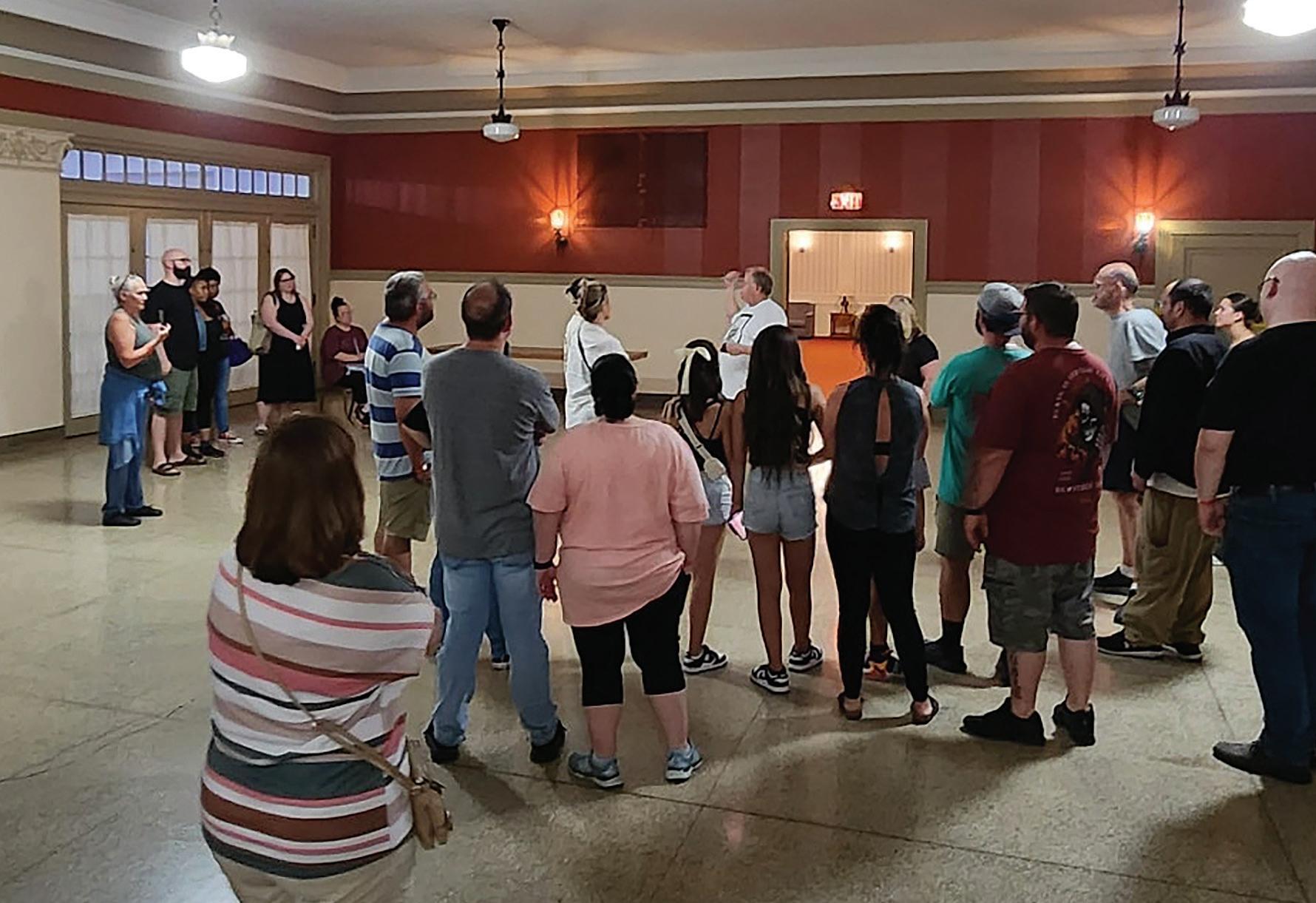
continued
In an interview with New Castle News, Rob Cummings, 33°, who also is on the board of directors for the CDC, reported seeing the ghost of what they think is a little boy running across the first balcony. A past custodian also witnessed the spirit run through a wall. Several years ago, an elevator inspector was hired to raise the lift to inspect the hydraulic shaft. Knowing about the ghost of the little boy, he left Matchbox cars and trucks underneath it for him. No one else had access to that area. Lo and behold, the toys would be gone the next month when the inspector returned, said Cummings.

“He did that for several months and made a project out of it,” he added. “We never found the toys. Wherever they went, we’ve never found them, but they were never put back.”
As the supernatural evening winded down around 4 a.m. the next morning, Illustrious Bro. Cummings and James McKim, 32°, MSA, started to lock up all the doors and turn off the lights.
In an interview with New Castle News following the event, Brother McKim said:
For more information on your local Center and how you can help students access essential tutoring resources, please visit: www.ChildrensDyslexiaCenters.org !

“We were cleaning up the concession stand, and Rob said he was going to the kitchen to get a cart. I was in the lobby alone, and I heard a man’s voice.” He couldn’t discern what the man was saying but added, “It was so spooky. It was four syllables, a short pause, two more syllables, and would repeat that,” he said. “I thought someone left a radio here, or someone was still in the building, or one of those ghost machines was around.”
When Rob returned, he stopped to listen and heard it too, McKim said. “We both got a little creeped out.” Searching upstairs, downstairs, and in the auditorium, they say the sound continued for about 15 minutes.
“It was a calm voice. It was the same volume no matter what room we were in, which was really odd,” McKim said. Finally, when they went to the mezzanine and the two were discussing what to do, the voice stopped.
McKim, who spent almost 12 years as a consultant, Foundation board member, and Cathedral volunteer said, “That’s the most haunted I’ve ever felt during my whole time there.”
With the overwhelming success of the first Ghost Night, the Valley of New Castle plans to hold a second one on January 24th. Check the Events section of their website at www.cathedralnewcastle.com for further details.

The


The





The Valley of Central Jersey celebrated their annual Cap and Jewel



The Valley of Milwaukee welcomed five new Brothers when they received their 4th degree as part of the Ill. Michael A. Burnham, 33°, Class.

enjoy themselves



On October 19, Maine Scottish Rite and Shrine joined forces for a one day class at Kora Temple. Massachusetts Consistory was on hand for their excellent version of the 22nd degree, Prince of Libanus. Thirty-nine Brothers became Scottish Rite Masons that day!
the
from
their 10th
a



On October 7, 2024, the Valley of Nashua held their Fall Reunion where four candidates began their Scottish Rite journey.



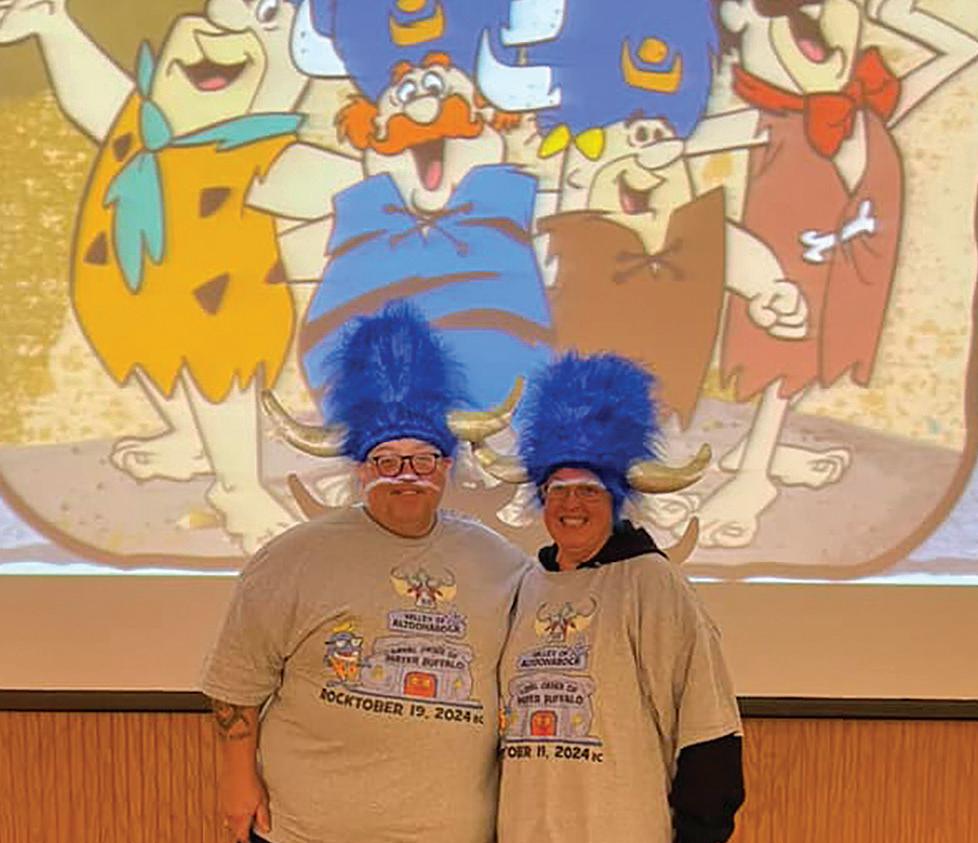
If you would like to have your Valley featured in Around the Jurisdiction, be sure to submit
On Tuesday June 25, 2024, Scottish Rite Freemasons and our Masonic family joined together to go ‘Over the Edge’ with the United Way to raise funds for the Children’s Dyslexia Centers of Nashua and Seacoast. Illustrious Roland Petersen, 33°, organized a team of five while Brother Dennis Tuttle Jr., 33°, organized a team of four participants to support the Seacoast Center. Each member of the team, including Brother Calvin Cline, 32°, of the Valley of Portsmouth-Dover (shown below), rappelled 24 stories down the Brady-Sullivan building in Manchester, NH. Brother Ron Carbary, 32°, MSA, reflected, “After completing my descent, I had a few moments to relax and contemplate the reason why we were here today. Charity at its core translates to love and compassion for others that extends to all humanity. Thank you to everyone who helped raise over $20,000 toward our Children’s Dyslexia Centers by supporting our Over the Edge team.”


WITH THE HOLIDAYS – and their accompanying parties – just around the corner, we thought it might be helpful to shed some light on what all of those dress code requirements mean. After all, a gentleman wouldn’t want to show up under- or over-dressed.

Keep in mind that this is a guide only. The best advice is to know the situation. If you’re not sure what is expected, ask the person who invited you. When in doubt, overdress a little. It’s easier to take off a jacket and tie than it is to try and dress up a pair of chinos and a polo shirt.


The high-end of dress codes. Men should wear (as the name implies) a white bowtie, white pique wing-collared shirt with studs and cufflinks, and a matching white vest, a black tailcoat and tuxedo pants along with formal shoes.
Ladies should wear full-length evening gowns. Fancy jewelry, hairdos and even gloves are completely appropriate.
Think: Cinderella or dinnertime at Downton Abbey
Men should wear a black tuxedo, white shirt with studs and cufflinks, and formal shoes. If the invitation reads “black tie,” then a black tie (either bow or necktie) and matching vest or cummerbund should be worn. “Formal” gives you some latitude with your tie and vest/cummerbund options, but you should avoid loud prints in favor of traditional formal colors.
Ladies should again wear fulllength gowns or below-the-knee cocktail dresses with heels.
Summer black tie means a white dinner jacket for the men, while ladies would tend toward the cocktail dress.
Think: The Oscars or most Masonic banquets
If you have a tuxedo, wear it. Accessorize it as described in the preceding category. If you don’t have a tuxedo, opt for a dark two- or three-piece suit, white shirt, conservative bowtie or necktie and leather dress shoes. A matching or complementary pocket square could complete the look.
Ladies have the option of fulllength gowns, fancy cocktail dresses, your “little black dress,” or even fancy separates. These can be accessorized with jewelry, and dressy shoes.
Think: Gala or formal wedding




Usually reserved for holiday or theme parties, festive allows you some creativity. Men should wear suits or sport coats with dress slacks. Shirts and ties appropriate to the theme are perfectly acceptable. Depending on the venue, ties may be optional. Ladies have the option of cocktail dresses, dressy skirt and tops, suit separates, or even pantsuits. Accessorize with jewelry, scarves, and colors appropriate to the theme.
Think: Christmas Party
For the men, business traditionally means a suit and tie. The suit is usually dark and the tie conservative, but that isn’t always the case. Lighter suits and brighter ties are acceptable in the summer, but loud prints should still be avoided.
For the ladies, a businessstyle dress or business suit is typical, but a pants suit is also acceptable. High or low heels both work – let the situation dictate which you choose.
Think: IBM in the 1980s or a fancy dinner
This is one of the more confusing and wide-ranging dress codes. If you are unsure, the event itself may provide some clues.
For men, it could mean a polo shirt and chinos or a sport coat, slacks, and a dress shirt with no tie. Shoes can definitely be less dressy – loafers or moccasins are perfectly acceptable.
For the ladies, pencil skirts, dress pants, and chinos are all acceptable. Tops can range from polos to silk blouses to button down shirts. Flats, wedges, and low heels work as well.
Think: Business luncheon or most workplaces
Almost anything goes here. Khakis, nice jeans, golf shorts, cargo shorts, and Bermuda shorts work on the bottom. Nice tees, polos, buttondowns, and sweaters are fine on top. Sneaker, sandals, and loafers with optional socks are all fair game as well. Ladies can choose from khakis, jeans, or abovethe-knee skirts paired with t-shirts, casual blouses, or button downs. Flats, sandals, wedges, and low heels are fine.
Think: Cookout or family party
by Stacey Fraser, Assistant Curator Scottish Rite Masonic Museum & Library
Freemasons have served in every international conflict in modern history, including World War I. The two Masons profiled here exemplified commitment to their country.

General John Joseph Pershing (1860–1948)
BORN in Laclede, Missouri, Pershing trained as a teacher in his teens while teaching local Black schoolchildren in the late 1870s. He attended West Point from 1882 to 1886; as First Captain, the highest possible cadet rank, he commanded the honor guard that saluted President Ulysses S. Grant’s funeral train as it passed West Point in 1885.
Pershing was raised in 1888 in Lincoln Lodge No. 19 in Lincoln, Nebraska. A decade later, he solidified his military reputation by commanding the 10th U.S. Cavalry, the famed “Buffalo Soldiers,” during the Spanish-American War, earning the nickname “Black Jack.” Between 1905 and 1916, Pershing served as a military observer in both the Russo-Japanese War and the Balkans, base commander of Fort McKinley in the Philippines, and leader of the Mexico Punitive Expedition, an ultimately unsuccessful attempt to capture Mexican revolutionary Pancho Villa.
During World War I, Pershing was chosen to be Commander of the American Expeditionary Forces from 1917 to 1920, where he served with great success. Pershing approved the integration of the American all-Black 93rd Division with the French Army, a move that acknowledged the needs of the depleted and overstretched Allied forces.
Pershing received the 4th through 32nd Scottish Rite degrees in Wheeling, West Virginia, in 1920, and the 33rd degree in 1930. He was the honored guest of the Revolutionary War Sesquicentennial celebrations in Lexington, Massachusetts, in 1925. He died in Washington, D.C. and is buried in Arlington National Cemetery.
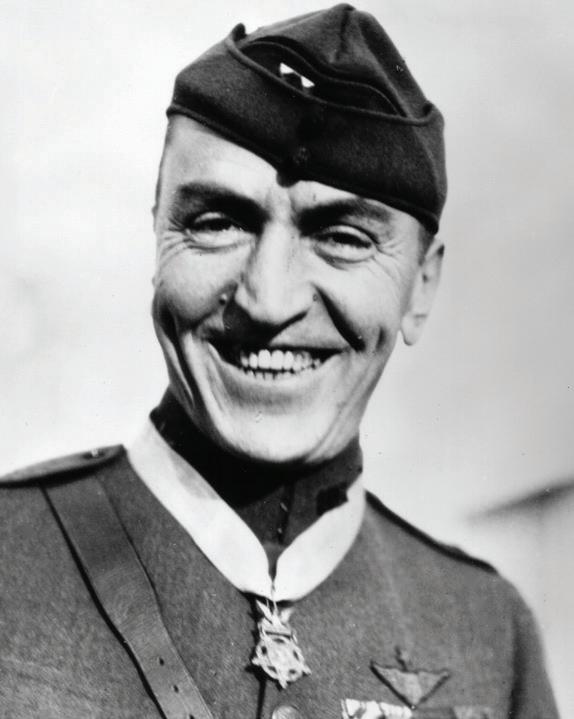
BORN in Columbus, Ohio, Rickenbacker’s fame came early. He became a race car driver at the age of 19 and successfully competed in well-known races, like the Indianapolis 500, from 1910 to 1917. He joined the American Expeditionary Forces in 1917, and his first assignment was to serve as a driver for Pershing. While in Europe, he often drove for members of Pershing’s aviation staff, which led to Rickenbacker’s eventual training as a fighter pilot in Tours, France. During the war, he secured 26 aerial victories, the most of any American pilot. Rickenbacker received the Medal of Honor in 1931 for his impressive service.
After the war’s end, Rickenbacker was raised at Kilwinning Lodge No. 297 in Detroit, Michigan, in 1922. He joined the Scottish Rite in 1927 and was coroneted a 33° Mason in 1942. He was also a Shriner, a Knight Templar, and a member of Los Angeles Elks Lodge No. 99.
Rickenbacker owned and operated the Indianapolis Motor Speedway from 1927 to 1941, closing it to save gasoline, rubber, and other resources during World War II. In 1942, while touring air bases in the Pacific Theater of Operations, the plane in which he was a passenger crashed into the Pacific. Rickenbacker and the crew were rescued after 24 days, enabling him to later deliver a secret message that President Franklin Roosevelt had asked him to carry to General Douglas MacArthur on the trip.
Rickenbacker also owned and operated Eastern Air Lines from 1938 to 1963. He died in Zurich, Switzerland, and is buried in Columbus, Ohio.




















